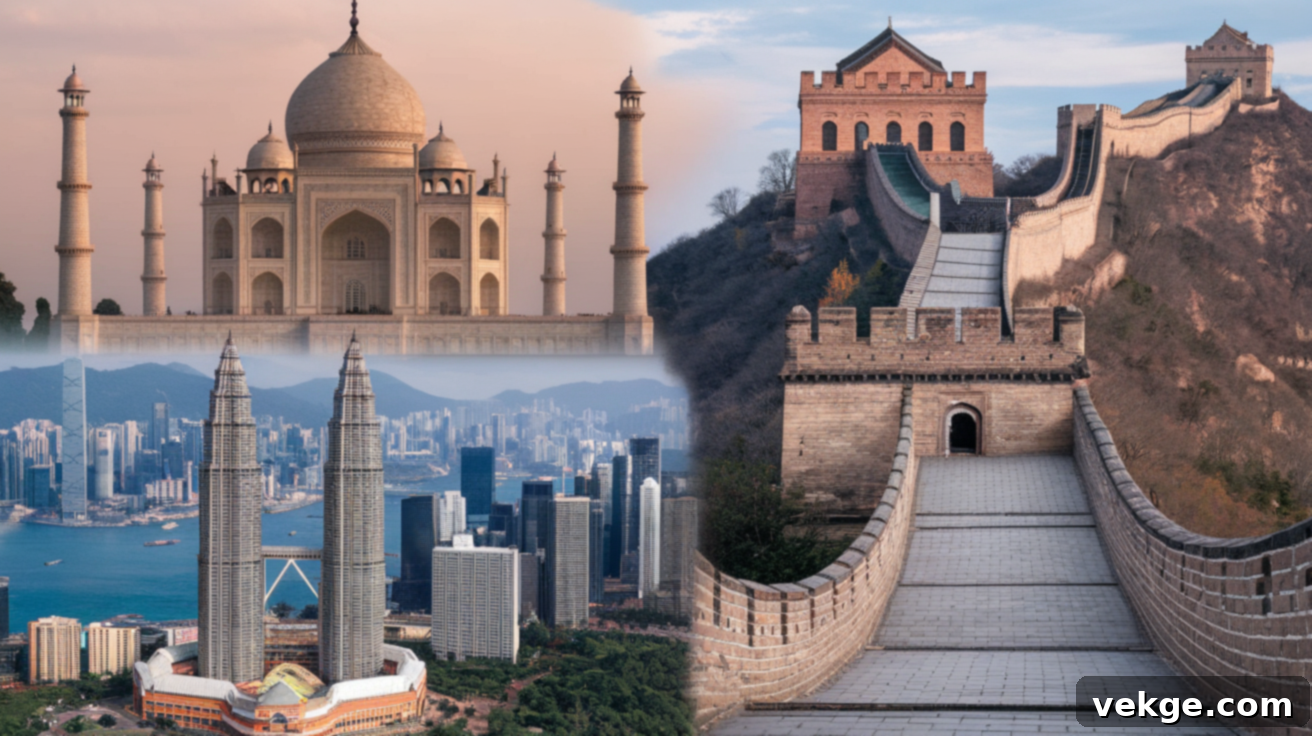Discover Asia’s Most Iconic Landmarks: Your Ultimate Guide to Must-Visit Sights
Have you ever dreamt of witnessing Asia’s most famous landmarks up close? Perhaps you’re meticulously planning your next adventure, curating an ambitious bucket list, or simply curious about the incredible wonders that make this continent so special. Asia is a realm of unparalleled diversity, where ancient histories intertwine with futuristic innovation, and breathtaking natural landscapes meet magnificent human achievements.
This comprehensive guide invites you on a virtual journey through some of the most amazing sights across Asia. From sacred ancient temples and majestic royal palaces to towering modern skyscrapers and awe-inspiring natural formations, we’ve curated a list of must-visit places. Each entry provides a glimpse into what makes these sites truly unique, along with practical tips on the best times to visit, helping you plan an unforgettable experience.
Our carefully selected landmarks aren’t just random picks; they’re chosen to spark your imagination, save you valuable planning time, and enhance your travel itinerary. Prepare to be inspired as we unveil the stories and grandeur behind these iconic destinations. Which of these famous landmarks will capture your imagination first? Let’s embark on this discovery!
Why These Landmarks Matter
Landmarks are far more than just picturesque spots on a map; they are vibrant repositories of history, culture, and humanity’s enduring spirit. Each site on this list tells a powerful story, reflecting the dreams, profound beliefs, artistic prowess, and engineering genius of the civilizations that created them. They stand as silent witnesses to centuries of human endeavor, resilience, and transformation.
Beyond their historical significance, these remarkable places continue to inspire travelers, artists, scholars, and dreamers across the globe. They serve as potent reminders that dedication, boundless imagination, and the pursuit of beauty can leave an indelible mark on the world, a legacy that withstands the test of time. A visit to these landmarks isn’t merely sightseeing; it’s an immersive experience, a profound connection with the past, a vibrant embrace of the present, and an active participation in a story that continues to unfold into the future.
Famous Landmarks in Asia You Should Visit
Prepare to be mesmerized by these unparalleled landmarks, each representing a pinnacle of human artistry or natural grandeur. These are the places that truly deserve a spot on every traveler’s lifetime itinerary, offering a blend of stunning aesthetics and profound historical or cultural resonance.
1. Taj Mahal, India

The Taj Mahal, majestically situated in Agra, stands as one of the most recognized and celebrated landmarks worldwide. Commissioned by Emperor Shah Jahan as an eternal tribute to his beloved wife, Mumtaz Mahal, this breathtaking white marble mausoleum is revered for its perfect symmetry, intricate pietra dura inlays, and the serene beauty of its surrounding gardens. Often hailed as the ultimate symbol of eternal love, its delicate carvings and reflective pools create an ethereal atmosphere that captivates every visitor.
Best Times to Visit: The ideal period to experience the Taj Mahal’s splendor is from November to February. During these months, the weather is cooler and more pleasant, making it perfect for leisurely strolls around the complex and enjoying the intricate details without the intense heat.
Visiting Hours: The Taj Mahal is open daily from sunrise to sunset, remaining closed only on Fridays for prayer. To truly appreciate its beauty with fewer crowds and benefit from the soft, golden light ideal for photography, an early morning visit is highly recommended.
2. Hawa Mahal, India

Known affectionately as the “Palace of Winds,” Hawa Mahal is an iconic five-story structure nestled in the heart of Jaipur. Constructed from distinctive pink and red sandstone in 1799, its facade is adorned with an astonishing 953 small, intricately latticed windows (jharokhas). This unique design allowed royal women to observe vibrant street festivals and daily life below without being seen, while also creating a natural, cooling airflow within the palace, a testament to ancient Indian architectural ingenuity.
Best Times to Visit: To enjoy comfortable sightseeing, plan your trip between October and March. The cooler weather during these months provides the best conditions for exploring Jaipur’s vibrant attractions, including the Hawa Mahal.
Visiting Hours: Hawa Mahal welcomes visitors daily from 9:00 AM to 4:30 PM. A morning visit is particularly rewarding, as the softer sunlight beautifully illuminates its colorful facade, creating perfect photo opportunities.
3. Golden Temple, India
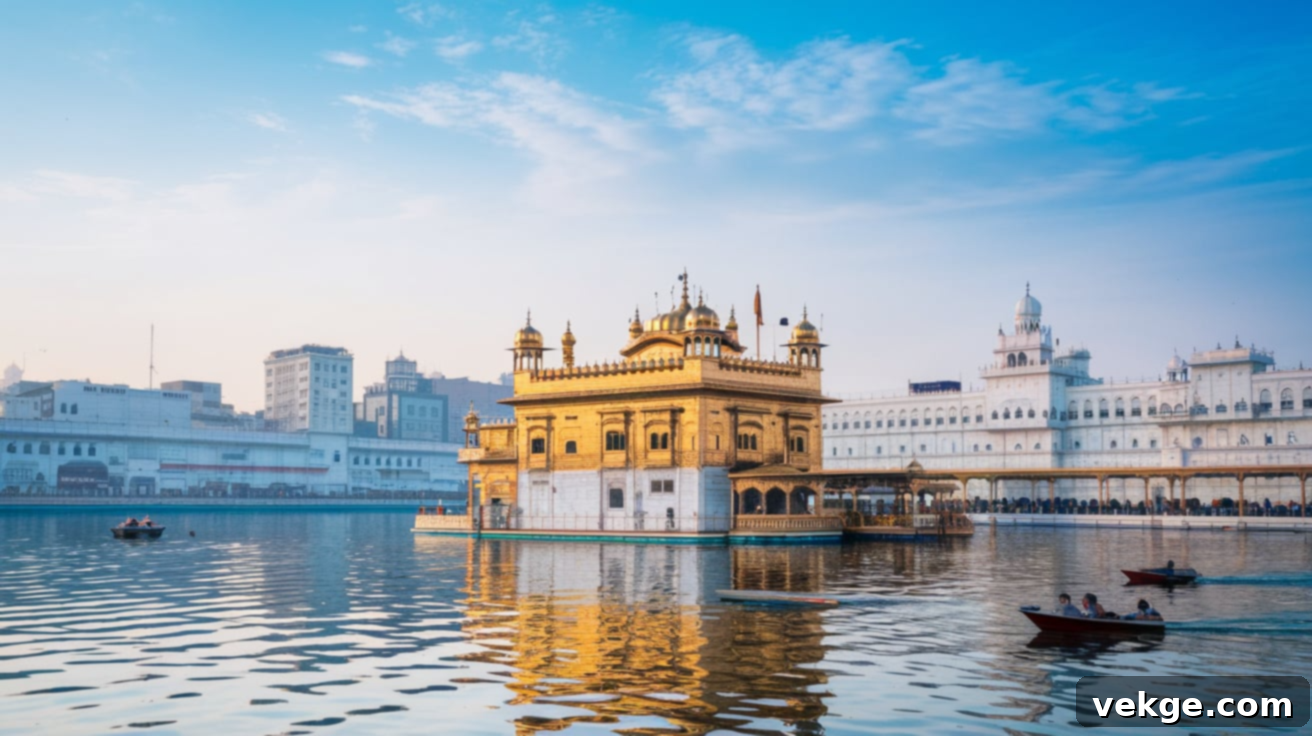
The Golden Temple, or Harmandir Sahib, located in Amritsar, is the holiest shrine of Sikhism and a breathtaking architectural marvel. Its stunning gold-plated exterior shimmers magnificently, reflected in the sacred Sarovar (pool) that surrounds it, creating an aura of unparalleled serenity. This spiritual sanctuary embraces all people, regardless of their faith, embodying principles of equality and community. It famously operates a vast community kitchen (Langar) that provides free meals to thousands of visitors every day.
Best Times to Visit: The most comfortable time to visit the Golden Temple is from November to March, when Amritsar experiences cooler and more pleasant weather, enhancing the overall experience.
Visiting Hours: Uniquely, the Golden Temple is open 24 hours a day, offering continuous spiritual access. However, visits in the early morning or late evening are particularly magical, providing a peaceful atmosphere and spectacular views of the temple’s golden reflection shimmering on the water under different lights.
4. Sigiriya Lion Rock, Sri Lanka
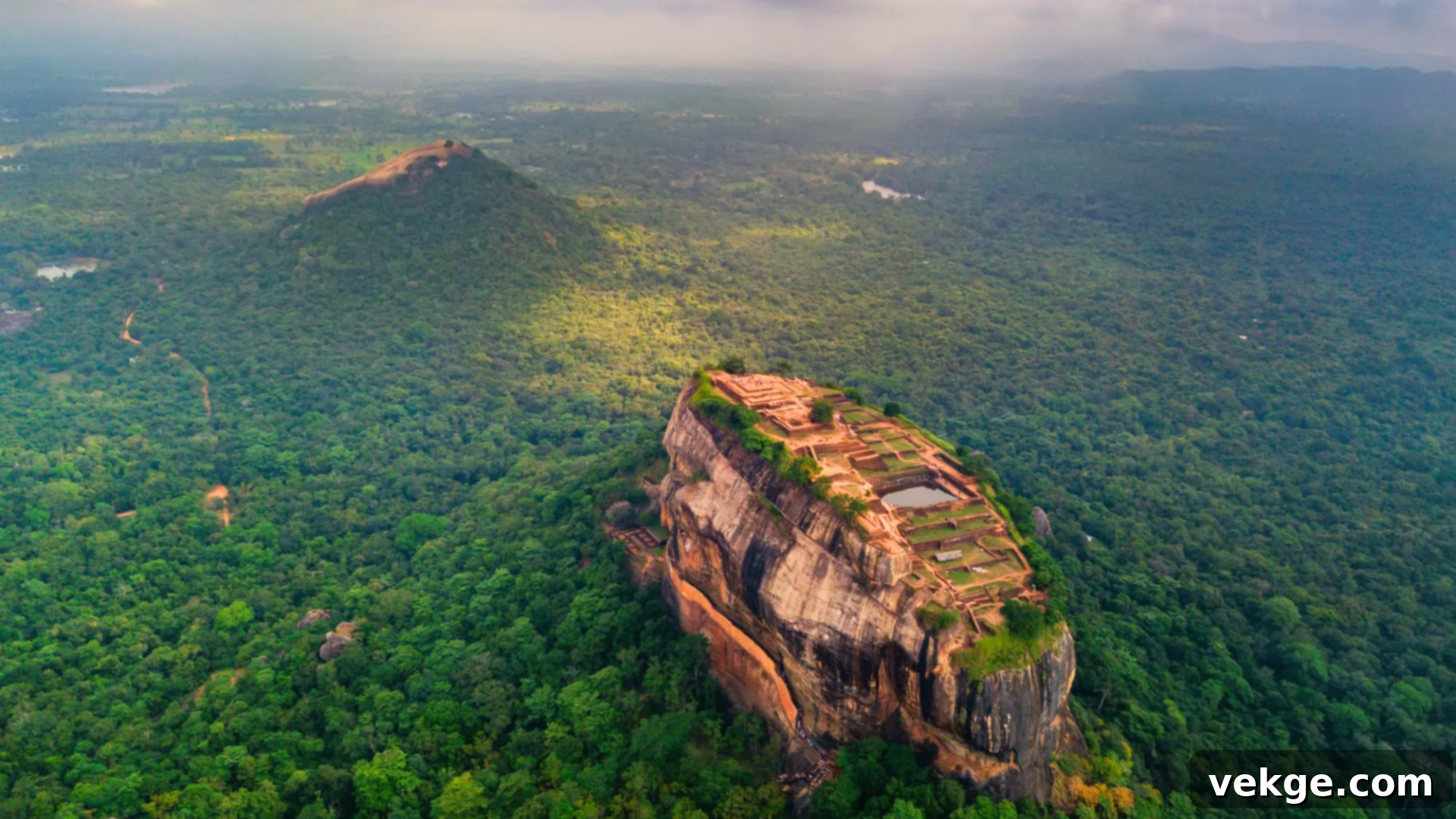
Sigiriya Lion Rock, a UNESCO World Heritage Site, is an ancient rock fortress and palace ruin dominating the central plains of Sri Lanka. Rising dramatically approximately 660 feet above the lush surrounding jungle, this colossal rock once housed the royal palace of King Kasyapa. The site is famous for its remarkably preserved vibrant frescoes, the colossal lion-shaped gateway that once guarded the entrance, and sophisticated water gardens, making it one of the country’s most iconic and historically rich landmarks.
Best Times to Visit: To avoid the monsoon rains and enjoy clearer, unobstructed views from the summit, the dry season from January to March is considered the best time to visit Sigiriya.
Visiting Hours: Sigiriya Lion Rock is open daily from 7:00 AM to 5:30 PM. An early morning ascent is highly recommended to beat the tropical heat and avoid the larger crowds, allowing for a more serene and enjoyable climb.
5. Nine Arch Bridge, Sri Lanka
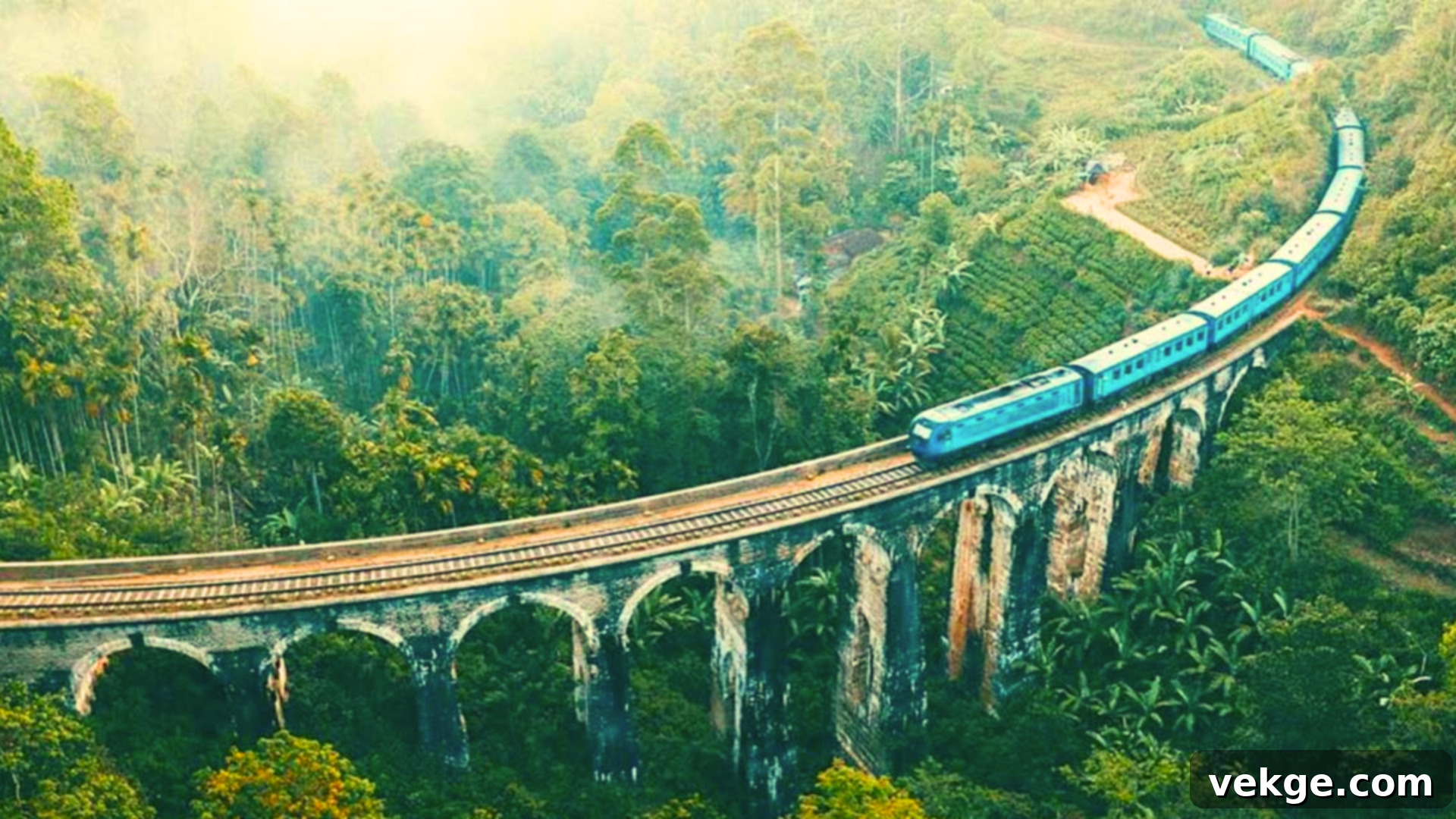
Tucked away in the beautiful hill country of Ella, the Nine Arch Bridge is a magnificent testament to colonial-era engineering and an architectural marvel. This impressive structure was built entirely from stone, bricks, and cement, famously without any reinforcing steel, showcasing incredible craftsmanship. With its nine graceful arches perfectly framed by verdant tea plantations and dense jungle, watching a train elegantly traverse the bridge through the misty landscape is a cherished and often photographed experience for many visitors to Sri Lanka.
Best Times to Visit: The period from January to March, during the dry season, is ideal for visiting the Nine Arch Bridge. The landscape is vividly green, and the weather is generally pleasant, perfect for hiking and photography.
Visiting Hours: The bridge is accessible throughout the day. However, early mornings often offer the most enchanting misty views and the best opportunities to witness a train crossing, providing truly picturesque scenes.
6. Bouddhanath Stupa, Nepal
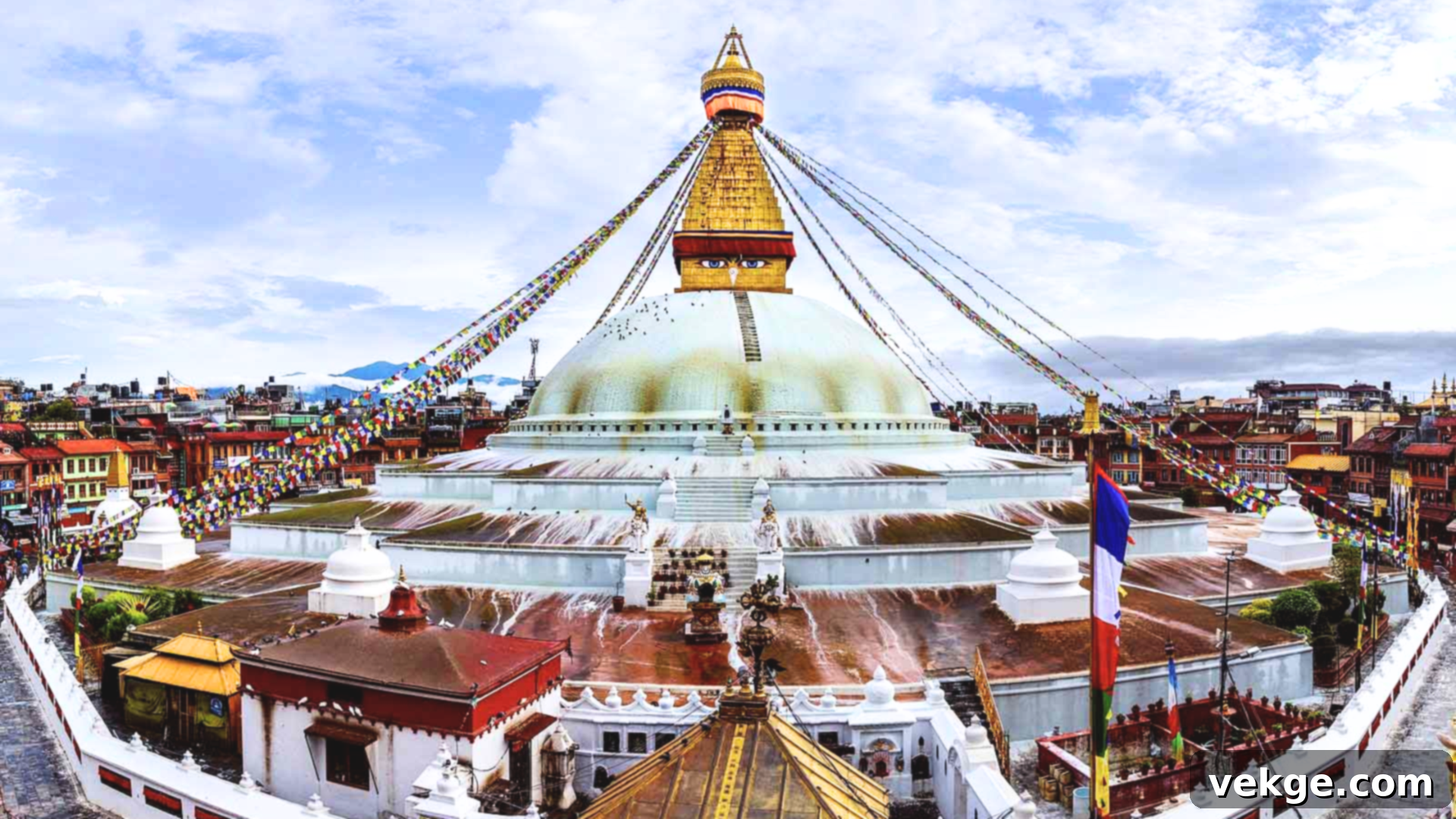
Bouddhanath Stupa, majestically rising in Kathmandu, is one of the largest and most significant Buddhist stupas globally and a UNESCO World Heritage Site. Its colossal white dome, crowned with a gilded tower from which the all-seeing eyes of Buddha gaze in every direction, radiates a profound sense of peace and spirituality. The rhythmic flutter of colorful prayer flags, strung from the spire, and the gentle whir of spinning prayer wheels held by devotees circling the stupa, create a deeply peaceful and immersive spiritual atmosphere.
Best Times to Visit: For clear skies and mild, comfortable weather ideal for exploring, plan your visit to Bouddhanath between October and May.
Visiting Hours: The stupa is generally open daily from around 5:00 AM to 6:00 PM. Early mornings and late afternoons are particularly special, offering the chance to observe local rituals, witness the soft light illuminate the stupa, and experience fewer crowds.
7. Mount Everest, Nepal

Mount Everest, the world’s highest peak, stands at a staggering 29,032 feet (8,848.86 meters) above sea level. Perched in the majestic Himalayas, straddling the border between Nepal and China, it represents the ultimate challenge and dream for mountaineers and trekkers worldwide. While a full ascent is an extreme endeavor, many adventurous travelers embark on scenic treks to nearby viewpoints, such as Kala Patthar, to witness breathtaking panoramic views of this colossal peak and the surrounding Himalayan range, an experience of unparalleled awe.
Best Times to Visit: For the clearest skies and most favorable trekking conditions, the pre-monsoon season (March to May) and the post-monsoon season (late September to November) are the optimal times to visit Everest region.
Visiting Hours: The Everest region is accessible year-round for trekking and tours, but weather conditions significantly impact safety and accessibility. Mornings typically offer the clearest and most spectacular views of the mountain.
8. Tiger’s Nest, Bhutan
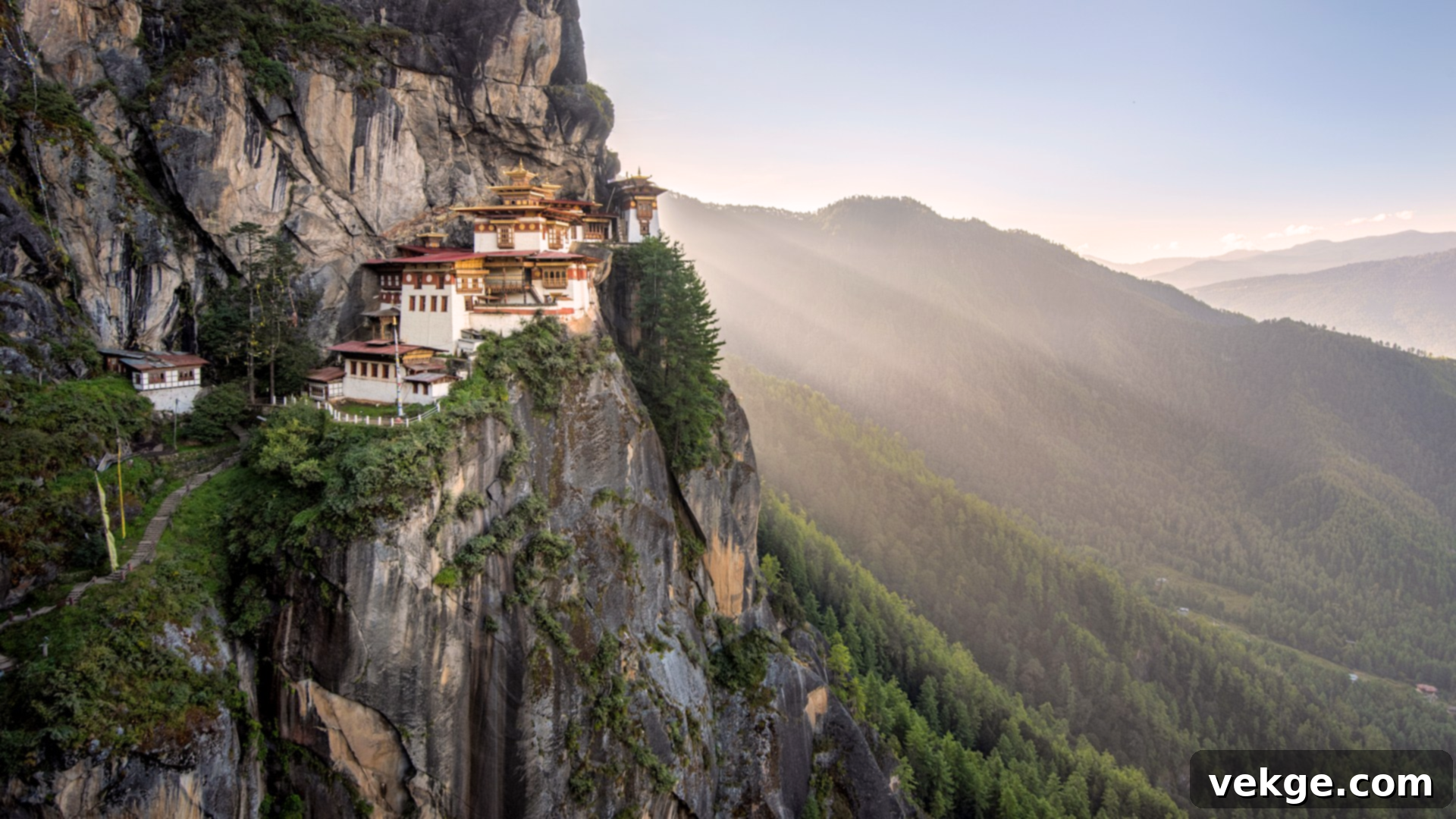
Tiger’s Nest, officially known as Paro Taktsang, is a sacred Buddhist monastery dramatically perched on a sheer cliff face, approximately 3,000 feet above the emerald Paro Valley. According to ancient legend, Guru Rinpoche, a revered Buddhist master, flew to this mystical spot on the back of a tigress to meditate. The challenging yet rewarding steep hike to reach the monastery offers not only stunning panoramic views of the valley below but also a profound sense of peace and spiritual connection that makes the strenuous effort entirely worthwhile.
Best Times to Visit: For excellent hiking conditions, clear skies, and vibrant scenery, the period between October and December is highly recommended for visiting Tiger’s Nest.
Visiting Hours: The monastery is generally open daily from 8:00 AM to 1:00 PM and then from 2:00 PM to 6:00 PM. Starting your hike in the morning is advisable to avoid the common afternoon clouds that can obscure views and to experience fewer crowds on the trail.
9. Cox’s Bazar, Bangladesh

Cox’s Bazar proudly holds the distinction of being home to the world’s longest natural sea beach, a spectacular stretch extending over 75 miles along Bangladesh’s southeastern coast. This magnificent coastline boasts expansive golden sands, gentle rolling waves, and picturesque rows of swaying palm trees, making it an idyllic destination for relaxation, exhilarating beach sports, and truly unforgettable sunset viewing. Beyond its natural beauty, the area buzzes with vibrant local markets and offers an abundance of fresh, delicious seafood, providing a rich cultural and culinary experience.
Best Times to Visit: The optimal time to visit Cox’s Bazar is from November to March. During these months, the weather is dry, sunny, and pleasantly comfortable, perfect for enjoying all beach activities.
Visiting Hours: As a natural beach, Cox’s Bazar is open all day. However, mornings and late afternoons are particularly ideal for enjoying comfortable temperatures and capturing stunning photographs under the beautiful natural light.
10. Badshahi Mosque, Pakistan
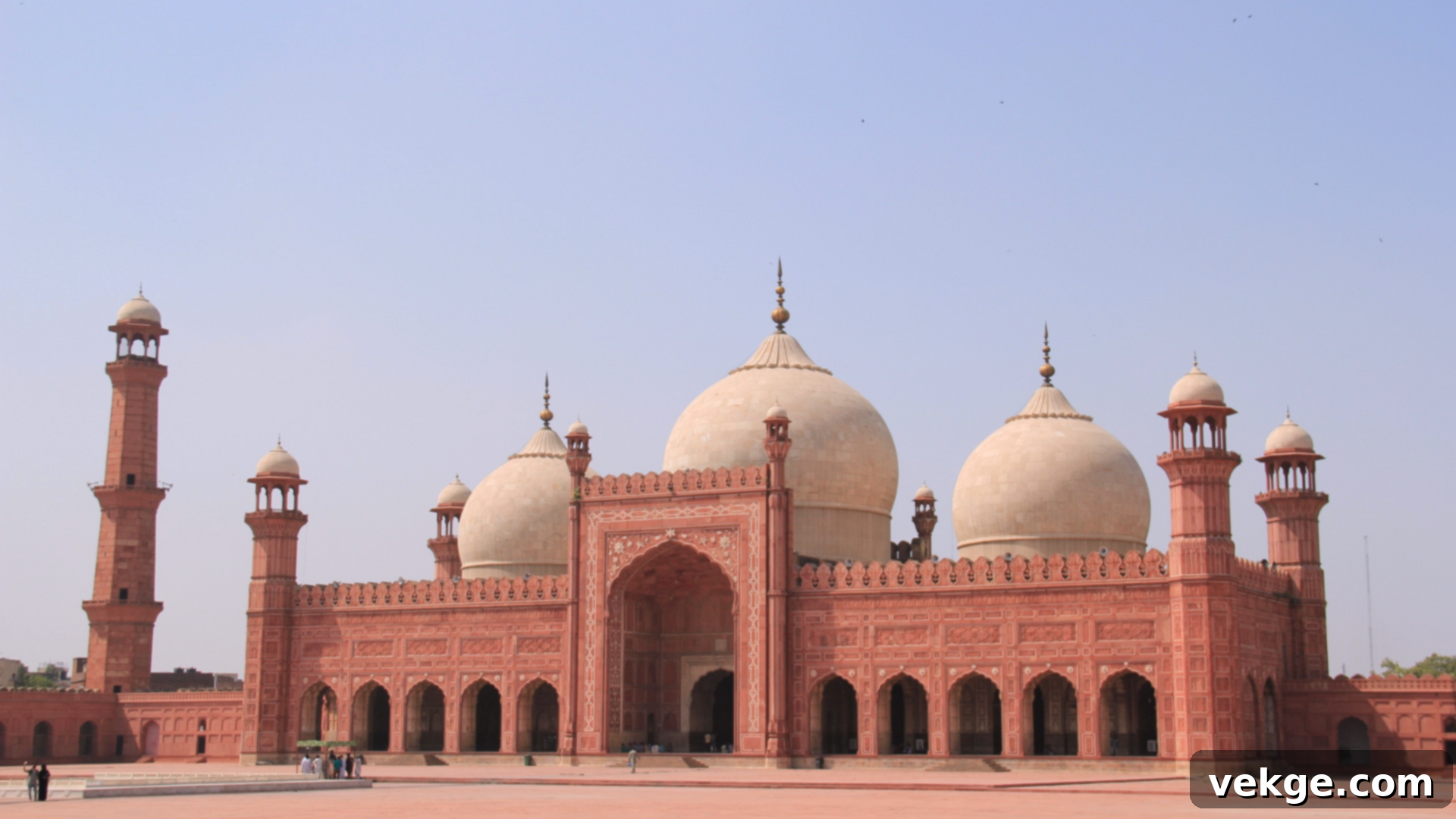
The Badshahi Mosque, an architectural masterpiece located in Lahore, stands as one of the largest and most aesthetically stunning mosques globally. Erected in 1673 by the formidable Mughal Emperor Aurangzeb, it features impressive red sandstone walls, contrasting with grand white marble domes, and encompasses an enormous courtyard capable of accommodating tens of thousands of worshippers. This majestic edifice remains a profound symbol of opulent Mughal architecture, rich history, and the empire’s lasting legacy, captivating visitors with its sheer scale and intricate details.
Best Times to Visit: The cooler months from October to March offer the most pleasant weather conditions, making it an ideal time to explore the vast grounds and intricate details of the Badshahi Mosque.
Visiting Hours: The mosque is open daily from 8:00 AM to 8:00 PM. A visit in the early morning or late afternoon allows for softer light, which beautifully illuminates the mosque’s features, and generally fewer crowds, enhancing the peaceful experience.
11. Bagan, Myanmar
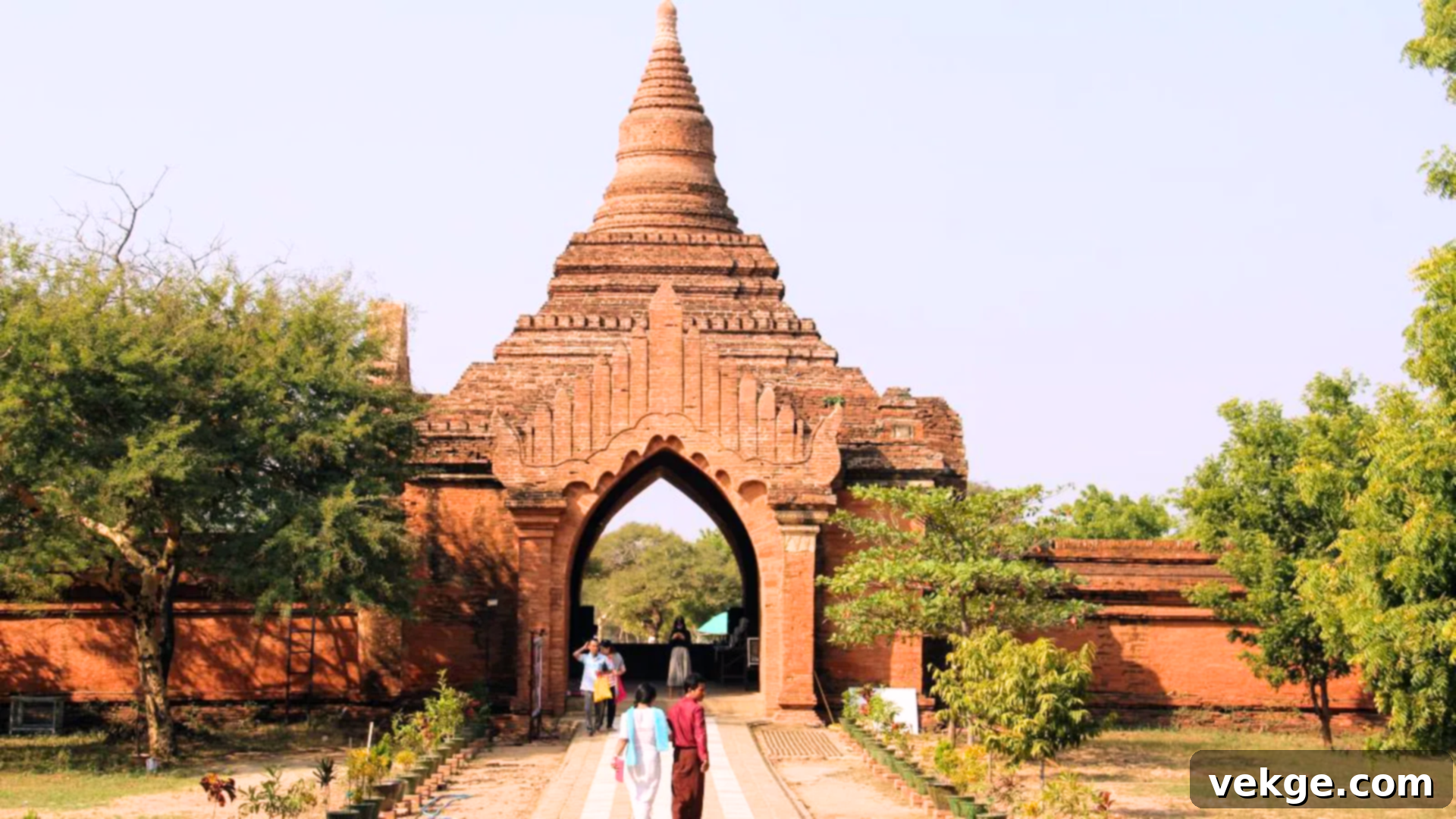
Bagan, an ancient city in Myanmar, is an extraordinary archaeological site featuring over 2,000 temples and pagodas scattered across a vast, enchanting plain. Constructed between the 9th and 13th centuries, these structures vary widely in size and architectural design, collectively creating a truly magical and unparalleled landscape, particularly at sunrise and sunset. For an utterly breathtaking perspective, hot air balloon rides over Bagan offer panoramic views of this historic wonderland, revealing its scale and beauty in an unforgettable way.
Best Times to Visit: The dry season, from November to February, is considered the best time to visit Bagan. During these months, skies are clear, temperatures are cooler, and hot air balloon rides are most consistently available.
Visiting Hours: The archaeological zone of Bagan is open all day. However, sunrise and sunset are the most popular and picturesque times to visit, offering dramatic lighting and cooler temperatures for exploration and photography.
12. Shwedagon Pagoda, Myanmar
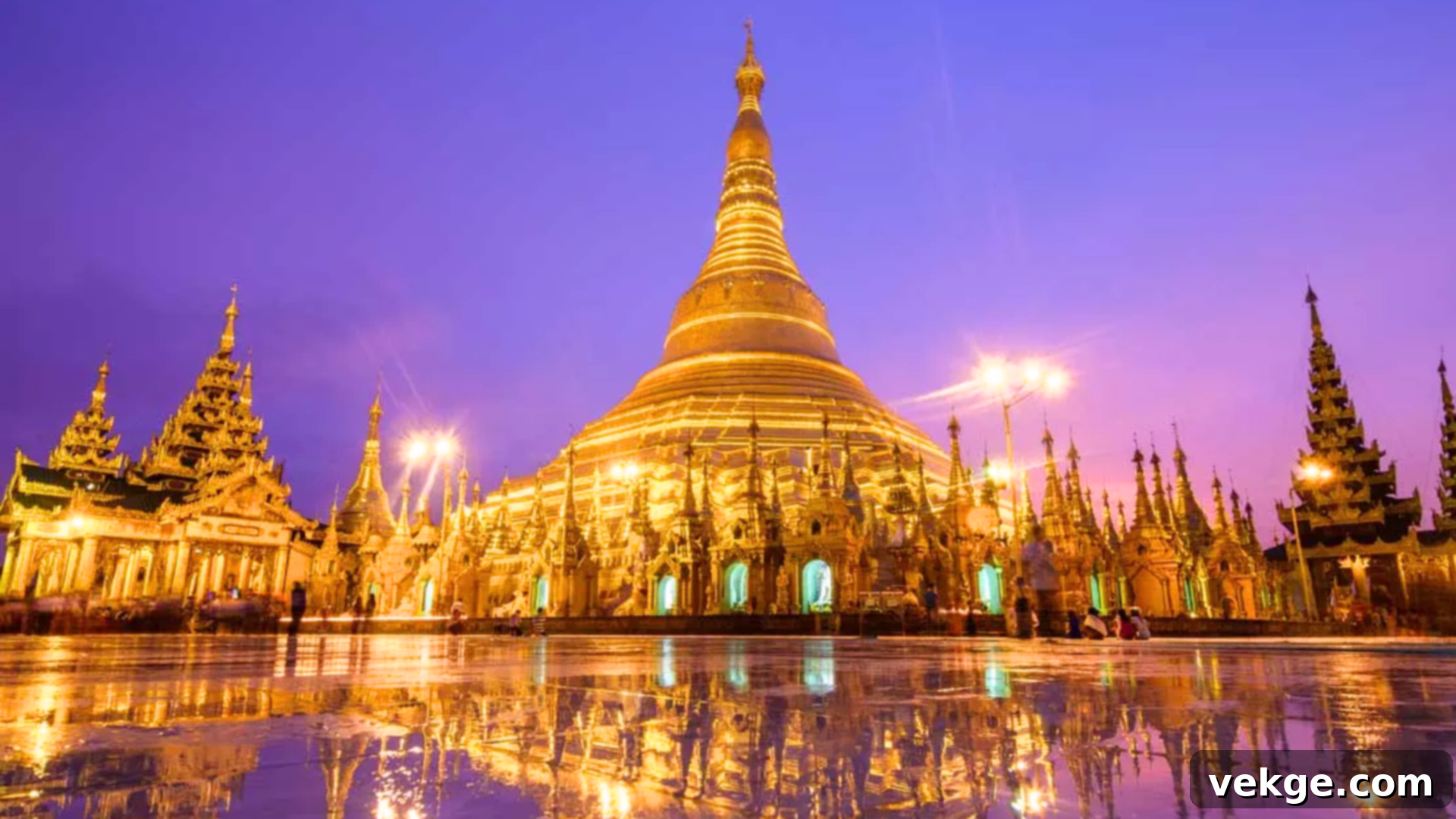
The Shwedagon Pagoda, majestically rising in Yangon, is Myanmar’s most sacred Buddhist site and a glittering marvel. This towering pagoda, standing approximately 326 feet tall, is completely covered in gold plates and adorned with thousands of diamonds and other precious gems, culminating in a magnificent finial. Believed to enshrine relics of four past Buddhas, its resplendent glow is particularly mesmerizing at sunrise and sunset, casting a golden hue over the city and offering a profound spiritual experience to all who visit.
Best Times to Visit: To enjoy pleasant weather and comfortable conditions for exploring the pagoda, the period between November and February, characterized by dry and cooler temperatures, is ideal.
Visiting Hours: Shwedagon Pagoda is open daily from 4:00 AM to 10:00 PM. Early mornings and evenings offer a serene atmosphere and the most stunning golden views as the pagoda catches the changing light, creating truly memorable photographic moments.
13. Angkor Wat, Cambodia
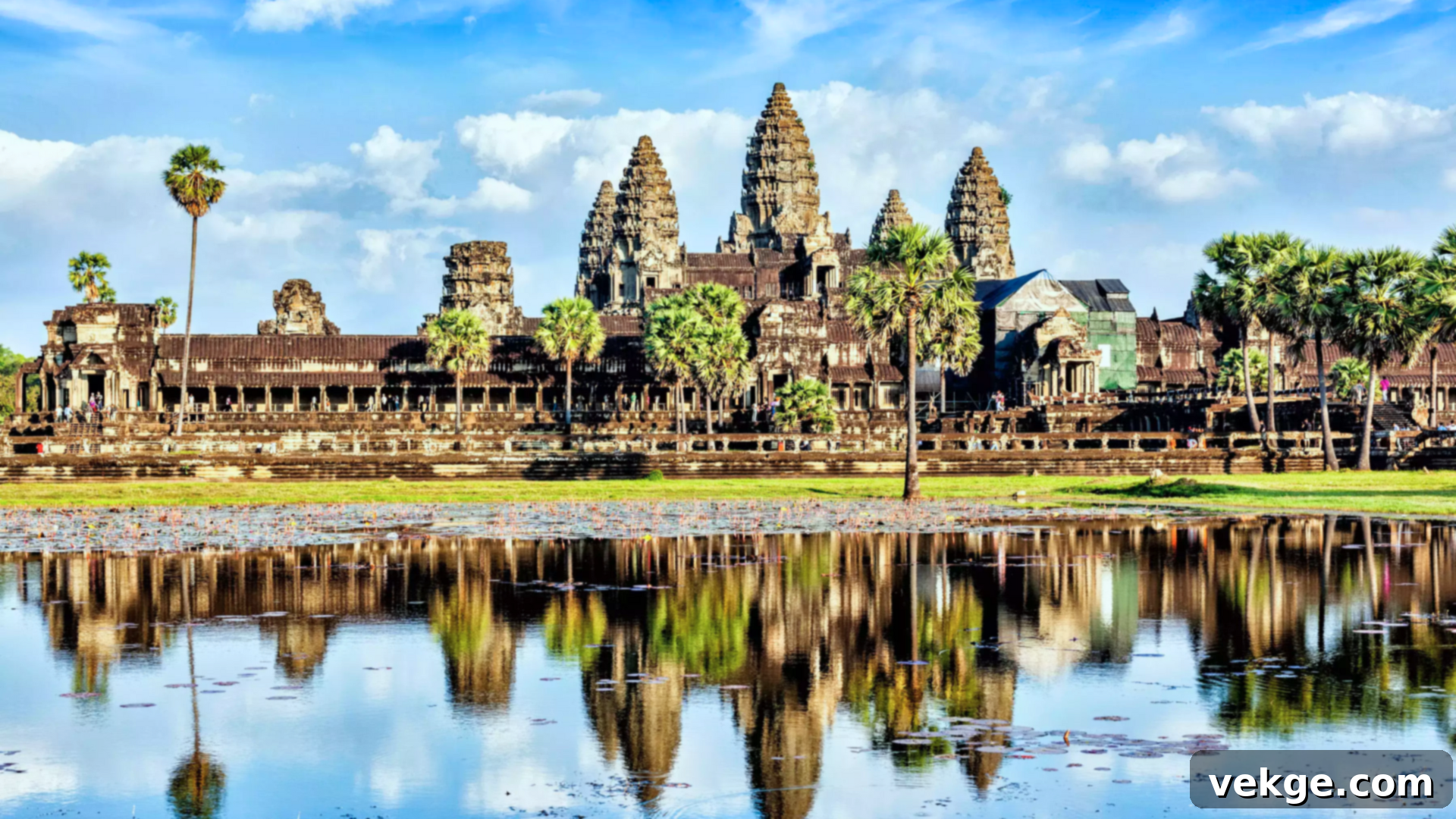
Angkor Wat, located near Siem Reap, holds the title of the largest religious monument in the world and is the crowning glory of Khmer architecture. Originally constructed as a Hindu temple dedicated to Vishnu in the 12th century, it gradually transformed into a Buddhist site. Its iconic soaring towers, intricately carved bas-reliefs depicting Hindu mythology, and expansive moats that mirror its grandeur, combine to make it one of the most awe-inspiring and historically significant landmarks in all of Asia, drawing millions of visitors each year.
Best Times to Visit: The period from December to February is considered the best time to visit Angkor Wat. During these months, the weather is cooler and drier, providing comfortable conditions for exploring the extensive temple complex.
Visiting Hours: Angkor Wat is open daily from 5:00 AM to 5:30 PM. Experiencing sunrise over the temple is an iconic and highly recommended activity, offering breathtaking views and the chance to beat the peak crowds.
14. Petronas Twin Towers, Malaysia

The Petronas Twin Towers, magnificent icons of Kuala Lumpur’s skyline, once held the title of the world’s tallest buildings and remain the tallest twin towers globally. Soaring to a height of 1,483 feet (452 meters), these gleaming structures are famously connected by a skybridge on the 41st and 42nd floors, offering spectacular city views. Their sleek, modern design, inspired by Islamic architectural motifs, and their dazzling illumination at night solidify their status as one of Malaysia’s most recognizable and photographed landmarks, symbolizing the nation’s progress and ambition.
Best Times to Visit: To enjoy generally drier weather and better conditions for sightseeing, consider visiting Kuala Lumpur and the Petronas Towers between May and July or from December to February.
Visiting Hours: The Petronas Twin Towers are open from Tuesday to Sunday, 9:00 AM to 9:00 PM, and are closed on Mondays. An evening visit is particularly magical, providing stunning panoramic views of the illuminated city lights from the observation deck.
15. Batu Caves, Malaysia
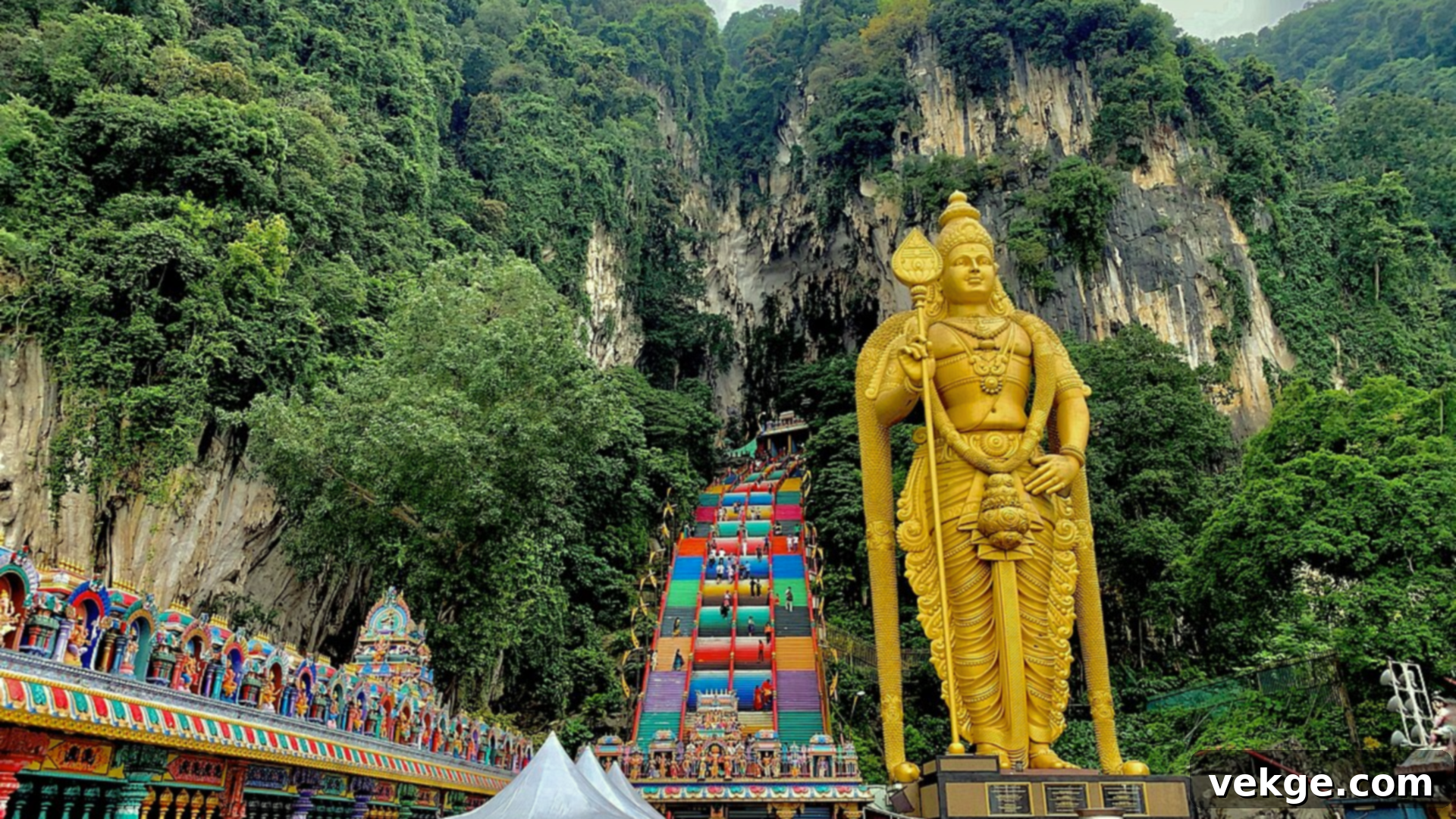
Just a short drive from Kuala Lumpur, the Batu Caves comprise a series of ancient limestone caves housing significant Hindu temples and shrines. At the base of the caves stands a colossal golden statue of Lord Murugan, welcoming visitors. To reach the main cave temple, visitors embark on a climb of 272 vibrant, colorful steps, a journey that offers incredible views and a sense of pilgrimage. The entire site comes alive with immense energy and vibrant celebrations, particularly during the annual Thaipusam festival, drawing devotees and tourists alike.
Best Times to Visit: The period from January to March is recommended for visiting Batu Caves, as the weather is typically drier and cooler, making the climb more comfortable.
Visiting Hours: Batu Caves are open daily from 6:00 AM to 9:00 PM. An early morning visit is advantageous for enjoying cooler temperatures and avoiding the larger crowds, especially when ascending the colorful steps.
16. Chocolate Hills, Philippines

The Chocolate Hills, a geological wonder located on Bohol Island, are an extraordinary collection of over 1,200 perfectly symmetrical, cone-shaped hills. What makes them truly unique is their transformation during the dry season: the lush green grass that covers these hills turns a rich brown, giving them the appearance of giant chocolate drops scattered across the landscape. Their distinctive shape, uniform size, and dramatic seasonal color change make them one of the Philippines’ most famous and captivating natural wonders, inspiring local legends and global fascination.
Best Times to Visit: To witness the hills in their iconic “chocolate” brown hue, visit between November and May, which is the dry season, ensuring clear skies and the most dramatic views.
Visiting Hours: The viewing decks for the Chocolate Hills are generally open daily from 8:00 AM to 5:00 PM. Morning visits are often preferred for cooler weather and fewer visitors, allowing for a more serene experience.
17. Borobudur, Indonesia
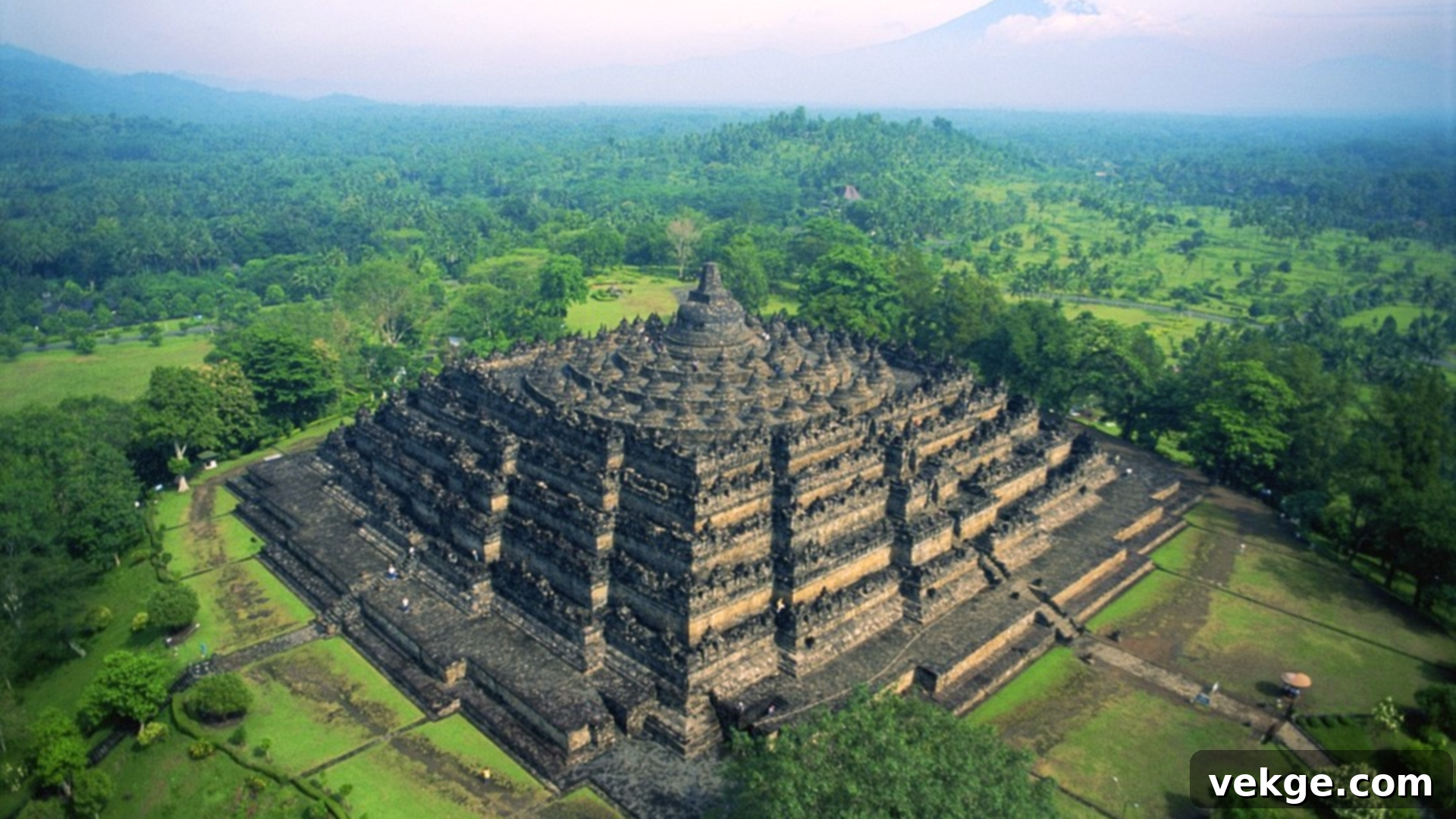
Borobudur, nestled in Central Java, stands as the largest Buddhist temple in the world and a UNESCO World Heritage Site. Constructed in the 9th century, this majestic structure features nine stacked platforms, culminating in a large central dome, and is adorned with over 500 Buddha statues and intricate narrative carvings that stretch for miles. The temple’s profound design intricately reflects Buddhist cosmology, and a visit at sunrise offers not only breathtaking panoramic views over the misty jungle but also a deeply spiritual and unforgettable experience as the ancient stones catch the first light of day.
Best Times to Visit: The dry season, from April to October, is the most favorable time to visit Borobudur, as the weather is more pleasant and rainfall is minimal, enhancing your exploration.
Visiting Hours: Borobudur is open daily from 6:00 AM to 5:00 PM. Sunrise visits are highly recommended for capturing stunning photographs, experiencing cooler temperatures, and enjoying the site with fewer crowds.
18. The Grand Palace, Thailand

The Grand Palace, a spectacular complex situated in the heart of Bangkok, served as the official residence of the Kings of Siam (and later Thailand) for over 150 years. This sprawling compound is a breathtaking display of traditional Thai architecture, featuring glittering golden spires, vibrant mosaic walls, and a collection of richly decorated buildings. Within its walls lies the revered Temple of the Emerald Buddha (Wat Phra Kaeo), housing a highly sacred Buddha image. Its intricate design, opulent decorations, and profound historical significance make it one of Thailand’s most visited and cherished landmarks, a true testament to the kingdom’s rich heritage.
Best Times to Visit: The cooler and drier months between November and February offer the most comfortable weather for exploring the vast grounds of The Grand Palace and enjoying the outdoor spaces.
Visiting Hours: The Grand Palace is open daily from 8:30 AM to 3:30 PM. Arriving early in the morning is highly recommended to avoid the heaviest crowds and the intense midday heat, allowing for a more pleasant and immersive visit.
19. Gardens by the Bay, Singapore
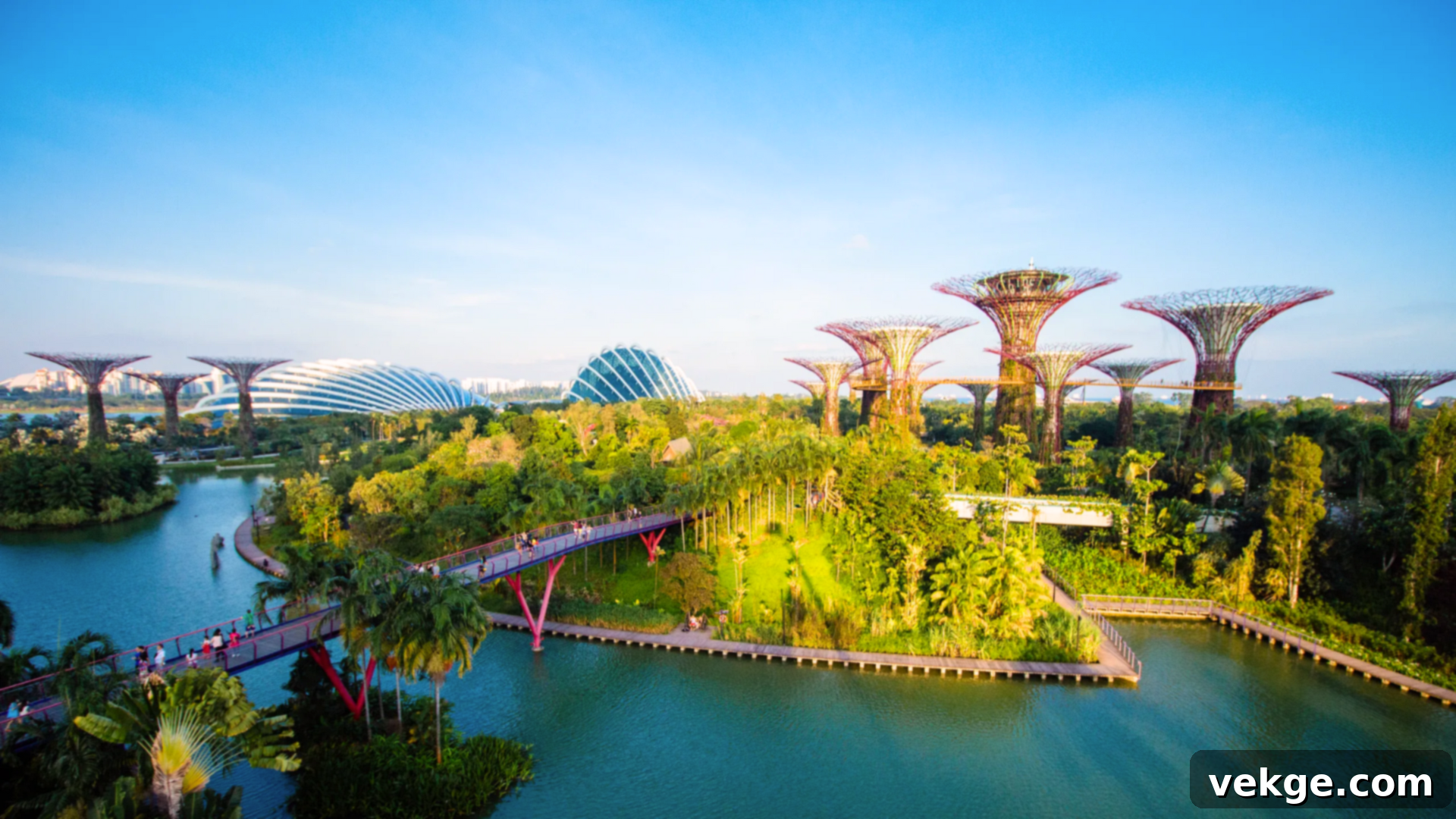
Gardens by the Bay is a visionary, futuristic park situated in the vibrant heart of Singapore, renowned globally for its iconic towering Supertree structures and impressive climate-controlled conservatories. Visitors can wander through the extraordinary Flower Dome, home to diverse flora from across the world, and the mystical Cloud Forest, featuring a towering indoor waterfall. The OCBC Skyway, linking several Supertrees, offers breathtaking panoramic views of the gardens and the city skyline. At night, the Supertrees come alive with a mesmerizing Garden Rhapsody light and music show, creating a truly magical atmosphere that blends nature with cutting-edge design.
Best Times to Visit: Gardens by the Bay can be enjoyed year-round due to Singapore’s tropical climate, but the period from February to April often offers slightly cooler and drier weather conditions, which can be more comfortable for exploring.
Visiting Hours: The outdoor gardens are open daily from 5:00 AM to 2:00 AM. The conservatories, such as the Flower Dome and Cloud Forest, operate from 9:00 AM to 9:00 PM, offering extended hours to experience their unique ecosystems.
20. Golden Bridge, Vietnam
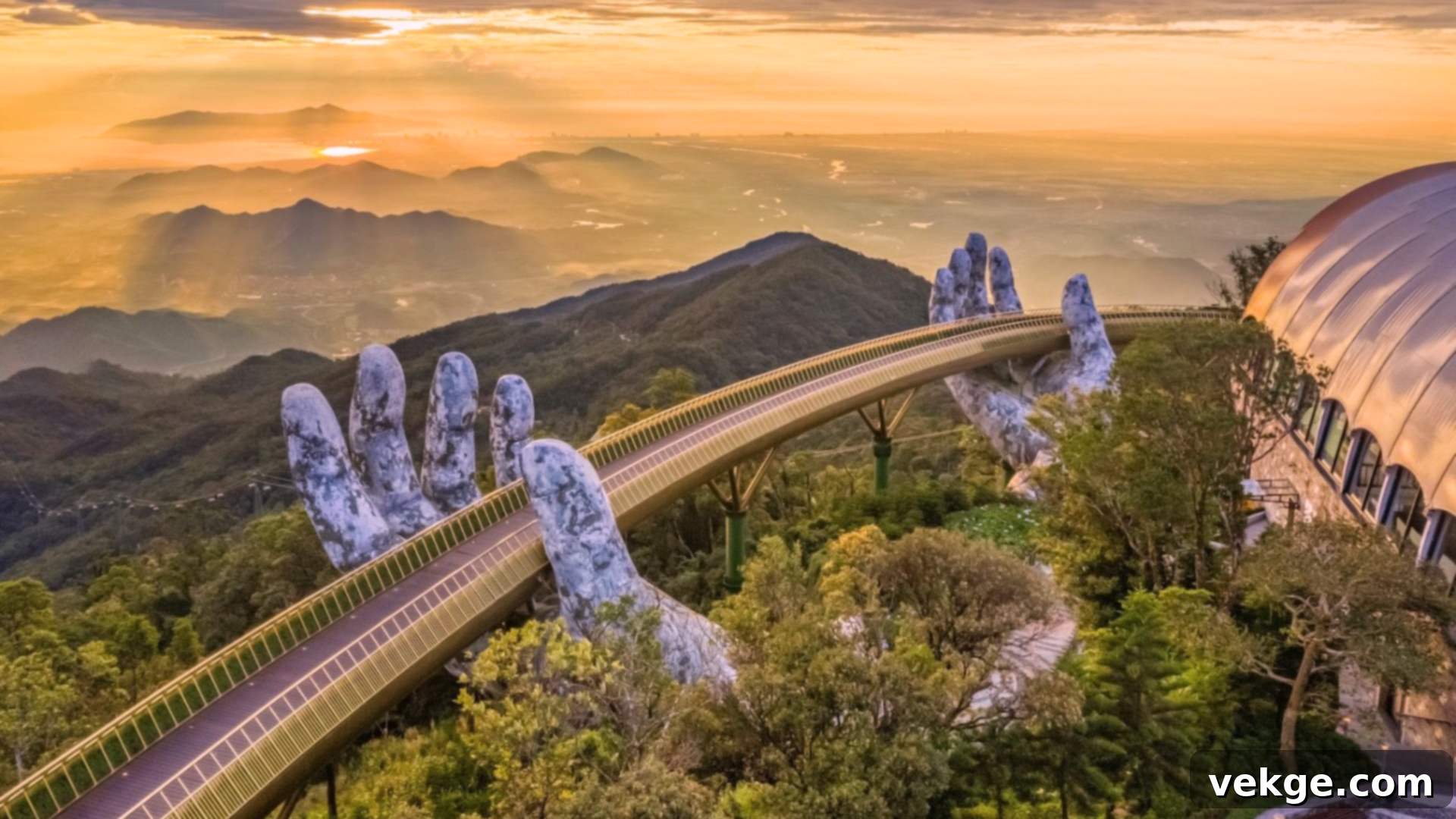
The Golden Bridge (Cau Vang), located in the scenic Ba Na Hills near Da Nang, is a spectacular pedestrian bridge that has rapidly become one of Vietnam’s most recognizable attractions. Opened in 2018, its striking design features a golden pathway seemingly held aloft by two enormous, ancient-looking stone hands emerging from the hillside, creating an illusion of divine support. The bridge offers breathtaking panoramic views of the lush mountains, verdant forests, and surrounding countryside, providing an unforgettable vantage point and a truly unique architectural experience.
Best Times to Visit: The best times to visit the Golden Bridge are from March to May and from September to November. During these periods, the weather is cooler and the skies are generally clearer, offering the best conditions for stunning views and photography.
Visiting Hours: The Golden Bridge is open daily from 7:00 AM to 10:00 PM. Visiting in the morning is highly recommended for cooler temperatures and to experience the bridge with fewer crowds, allowing for a more serene walk and unobstructed photo opportunities.
21. Ha Long Bay, Vietnam
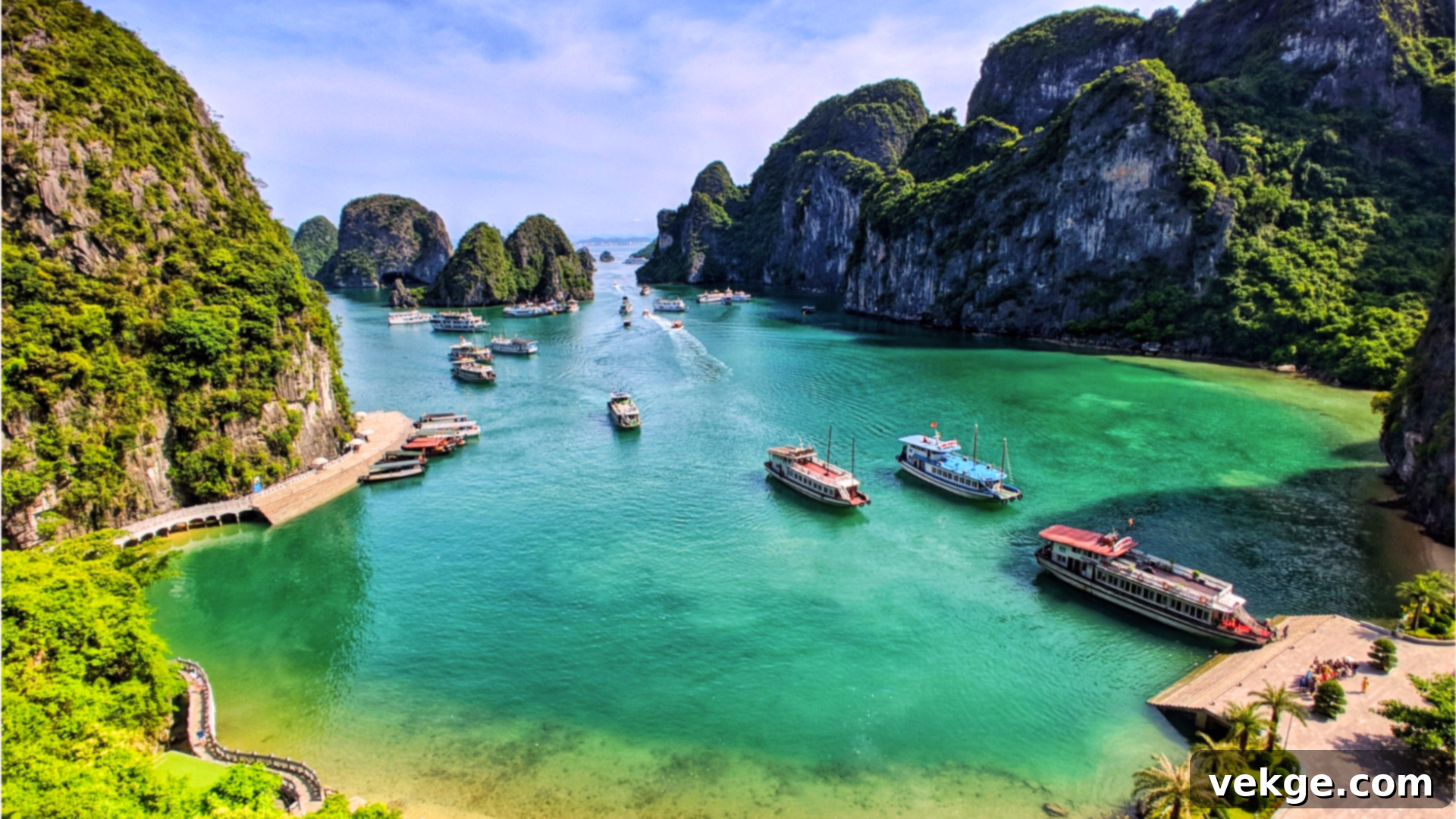
Ha Long Bay, situated in northern Vietnam, is a UNESCO World Heritage Site celebrated globally for its emerald waters and thousands of towering limestone karsts and islets, often topped with dense rainforests. This mystical seascape is dotted with hidden caves, pristine beaches, and traditional floating villages, creating a truly enchanting environment. The bay’s breathtaking natural scenery, characterized by its dramatic rock formations sculpted over millions of years, makes it one of Asia’s most iconic and unforgettable natural wonders, best explored by cruise.
Best Times to Visit: The period between October and December is ideal for visiting Ha Long Bay. During these months, the weather is cooler and drier, and the skies are generally clearer, offering optimal conditions for cruising and enjoying the stunning vistas.
Visiting Hours: Ha Long Bay is continuously open for tours and cruises throughout the day. Opting for an early morning cruise often provides the advantage of calmer waters and fewer crowds, enhancing the peaceful beauty of the bay.
22. Taipei 101, Taiwan
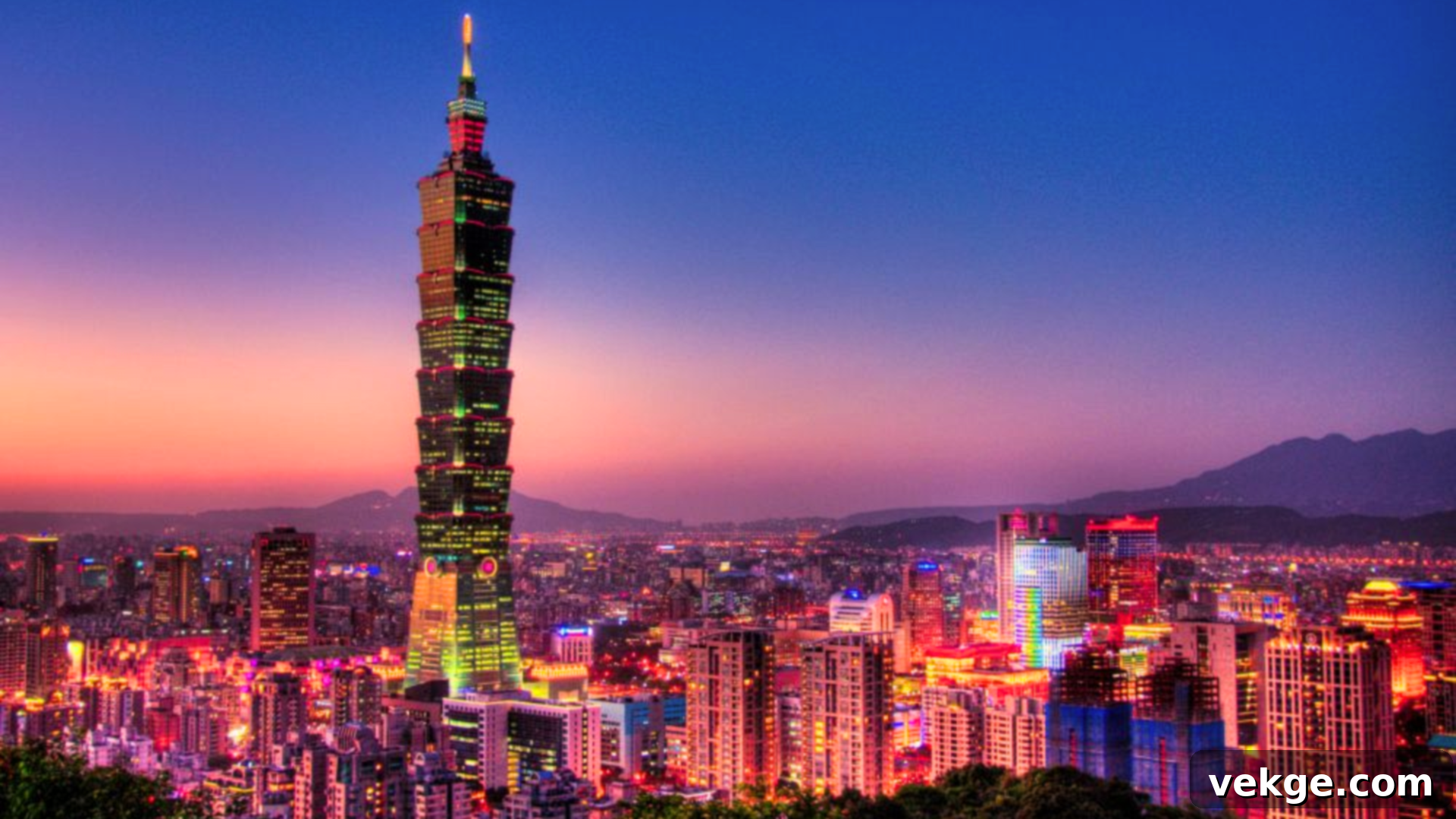
Taipei 101, an architectural marvel in the heart of Taipei City, once held the prestigious title of the world’s tallest building. Designed to resemble a colossal bamboo stalk, a symbol of growth and resilience, it gracefully ascends to 1,667 feet (508 meters) across 101 floors. The skyscraper is renowned not only for its incredible height and distinctive aesthetic but also for its high-speed elevators and a massive tuned mass damper, an innovative engineering feat that helps it withstand earthquakes and typhoons. Its observation decks offer unparalleled panoramic views of the bustling cityscape.
Best Times to Visit: For cooler weather and the highest chance of clear skies for optimal city views from the observation deck, plan your visit to Taipei 101 between October and February.
Visiting Hours: Taipei 101 is open daily from 11:00 AM to 9:00 PM. Evening visits are particularly popular for experiencing stunning views of the city lights shimmering below from the building’s impressive observation deck.
23. Great Wall of China
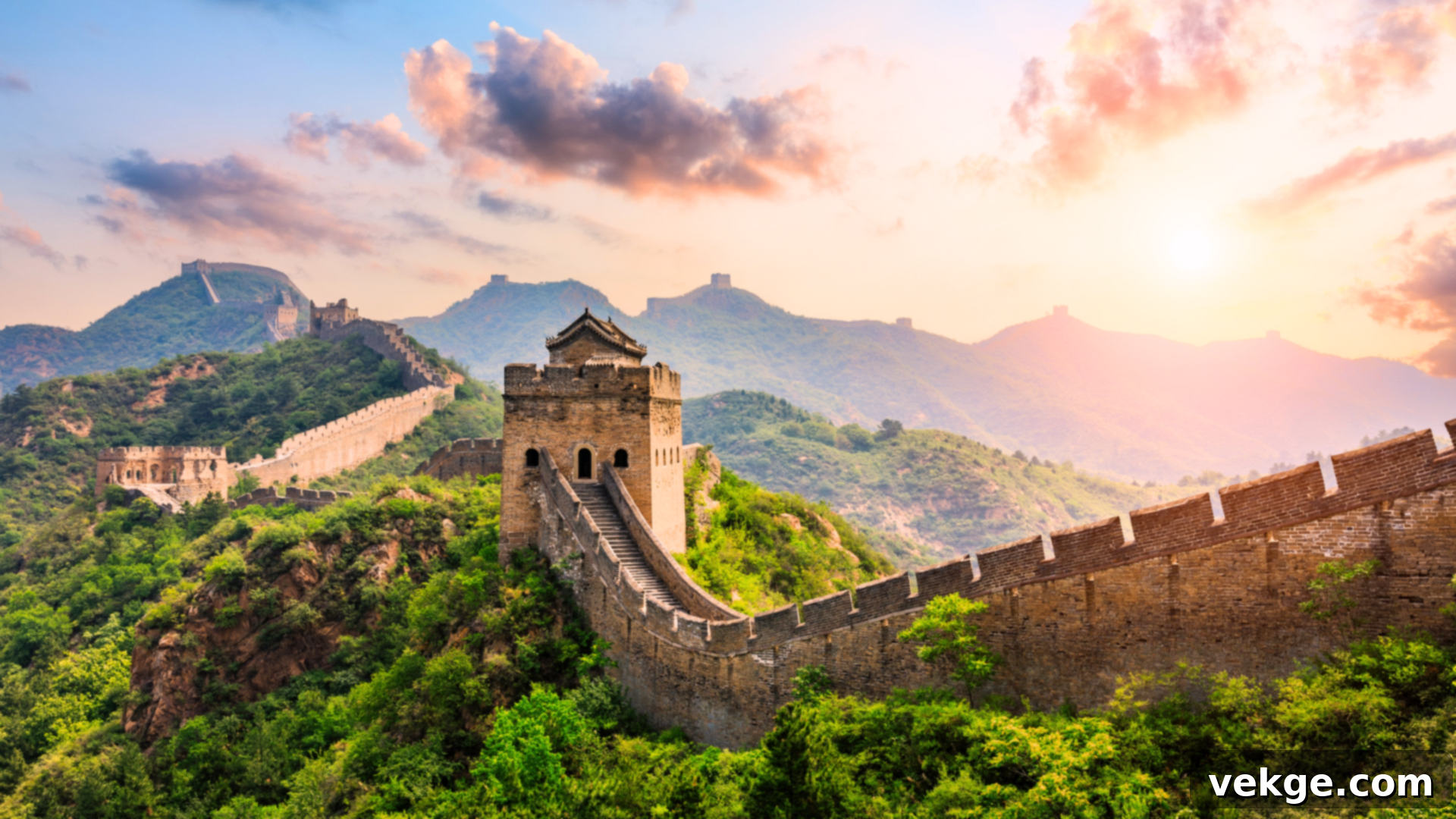
The Great Wall of China, an awe-inspiring series of fortifications, is one of humanity’s most monumental architectural achievements, stretching an astonishing 13,000 miles across diverse terrains including mountains, deserts, and plains. Primarily built and rebuilt during the Ming Dynasty, its original purpose was to protect China from invasions and raids. Today, it stands as an enduring symbol of Chinese history and engineering prowess, with numerous well-preserved sections open for hiking, exploring, and marveling at its sheer scale and historical significance.
Best Times to Visit: The ideal times to visit the Great Wall are during spring (April to May) and fall (September to October). These seasons offer mild temperatures, beautiful scenery with blooming flowers or vibrant autumn leaves, and comfortable hiking conditions.
Visiting Hours: Most accessible sections of the Great Wall are open daily from 7:30 AM to 5:30 PM. To avoid the heat and the largest crowds, an early morning visit is strongly recommended for a more tranquil experience.
24. Forbidden City, China
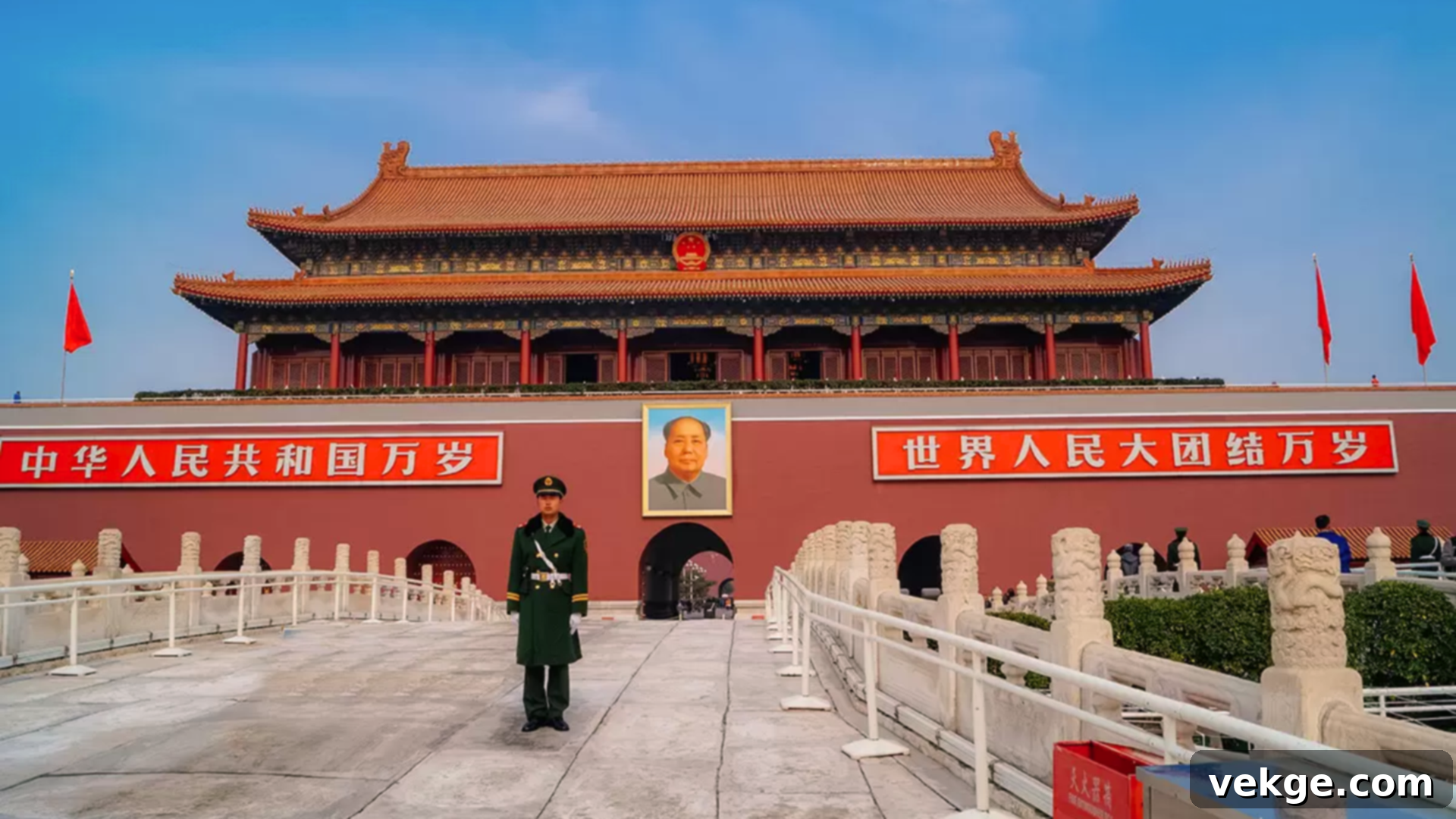
The Forbidden City, located in the heart of Beijing, served as the imperial palace for 24 Chinese emperors across nearly 500 years, from the Ming to the Qing dynasties. This colossal palace complex, spanning an immense 178 acres and reputedly containing 9,999 rooms, is the largest ancient palatial structure in the world. Its grand halls, distinctive golden roofs, and meticulously intricate designs offer an unparalleled glimpse into China’s rich royal past, imperial power, and profound cultural heritage, making it an essential visit for understanding Chinese history.
Best Times to Visit: The most comfortable times to explore the Forbidden City are during spring (April to May) or fall (September to October), when Beijing experiences pleasant weather and typically fewer tourist crowds.
Visiting Hours: The Forbidden City is open from Tuesday to Sunday, 8:30 AM to 5:00 PM, and is closed on Mondays (except for public holidays). Arriving early in the day is highly advisable to avoid large tour groups and to enjoy the majestic complex more peacefully.
25. Zhangjiajie National Forest Park, China
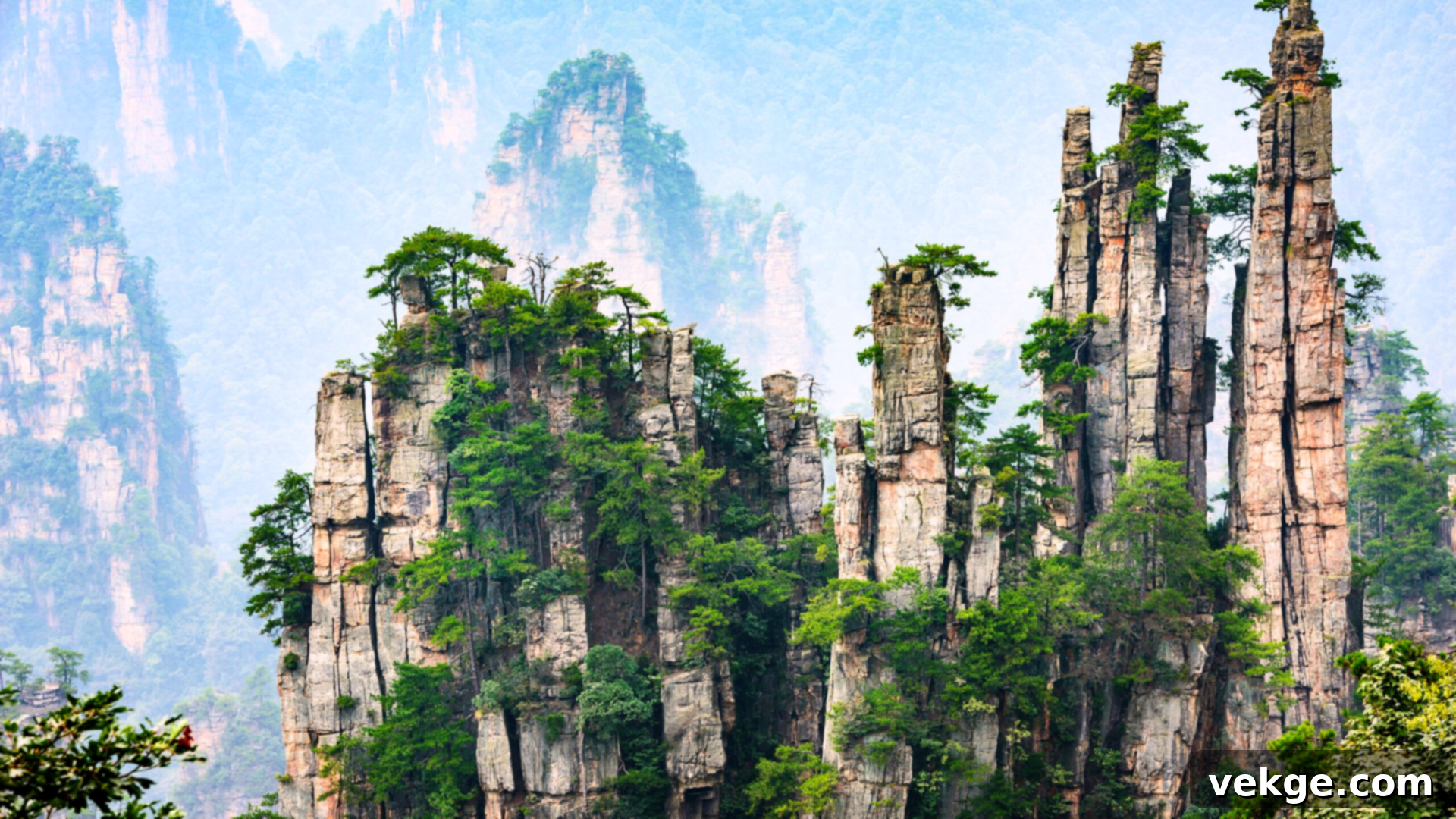
Zhangjiajie National Forest Park, nestled in Hunan Province, is a UNESCO World Heritage Site renowned for its surreal and towering sandstone pillars, which dramatically rise from the verdant landscape. These extraordinary natural formations famously served as the inspiration for the “floating mountains” in the blockbuster movie Avatar. The park offers an array of incredible attractions, including transparent glass bridges, exhilarating cable car rides that provide aerial perspectives, and scenic hiking trails that lead to unforgettable views of its misty peaks and lush, ancient forests, making it a dream destination for nature lovers and adventurers.
Best Times to Visit: The period between September and November is generally considered the best time to visit Zhangjiajie National Forest Park, offering cooler temperatures, clear skies, and the vibrant hues of autumn foliage.
Visiting Hours: The park is open daily from 7:00 AM to 6:00 PM. Visiting in the morning is highly recommended for clearer views before the characteristic mist often settles in and before the heaviest crowds gather.
26. Potala Palace, Tibet
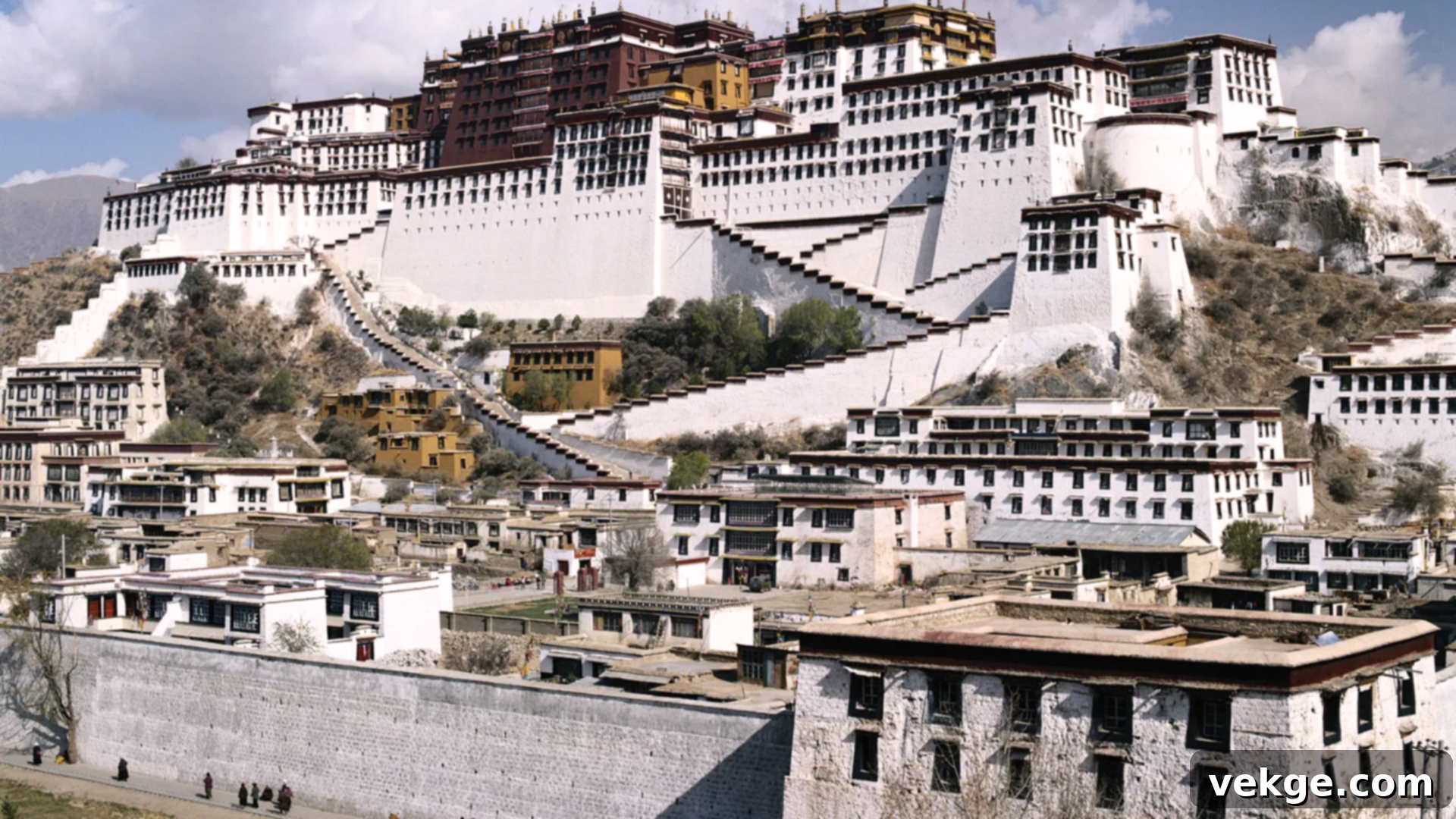
The Potala Palace, a magnificent 13-story fortress-palace, proudly dominates the skyline of Lhasa and is a UNESCO World Heritage Site. Perched atop Marpo Ri Hill, it served as the winter residence and spiritual administrative center of the Dalai Lamas for centuries. Within its imposing white and red walls, the palace houses over 1,000 rooms filled with ancient murals, intricate statues, sacred texts, and the gilded tombs of past Dalai Lamas. Its striking architecture and profound spiritual significance make it one of Tibet’s most iconic and revered landmarks, a powerful symbol of Tibetan Buddhism and culture.
Best Times to Visit: The period between May and October offers warmer weather and generally more favorable travel conditions for visiting Tibet and the Potala Palace, making exploration more comfortable.
Visiting Hours: Potala Palace is open daily from 9:00 AM to 4:00 PM. Due to strict daily visitor limits and timed entry, it is essential to arrive early and secure your tickets well in advance to guarantee access.
27. Fushimi Inari-Taisha, Japan
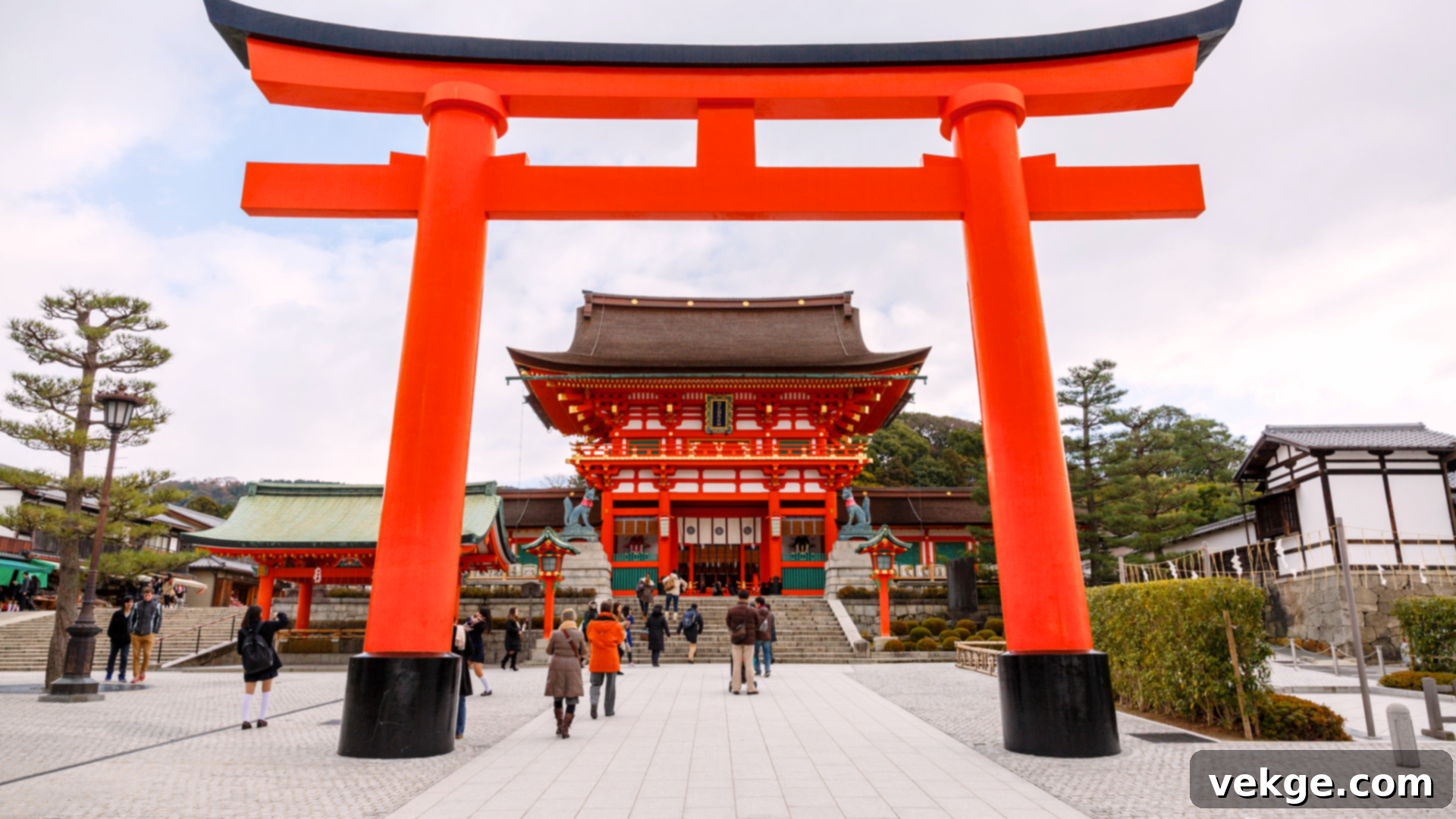
Fushimi Inari-Taisha, located in Kyoto, is one of Japan’s most ancient and iconic Shinto shrines, dedicated to Inari, the god of rice. It is famously recognized for its mesmerizing pathways formed by thousands of vibrant orange torii gates that wind up the sacred Mount Inari. Each torii gate has been generously donated by individuals or businesses as an offering, hoping for prosperity, good fortune, and success. The captivating sight of these gates stretching endlessly through serene forests creates a truly unique and deeply spiritual experience.
Best Times to Visit: For mild weather, comfortable walking conditions, and picturesque scenery, visit Fushimi Inari-Taisha in spring (March to May) when cherry blossoms appear, or in fall (October to November) for stunning autumn colors.
Visiting Hours: Remarkably, Fushimi Inari-Taisha is open 24 hours a day, allowing visitors to experience its unique atmosphere at any time. Early mornings or late evenings are particularly recommended to enjoy the peaceful paths without the bustling crowds and for beautiful lighting.
28. Mount Fuji, Japan
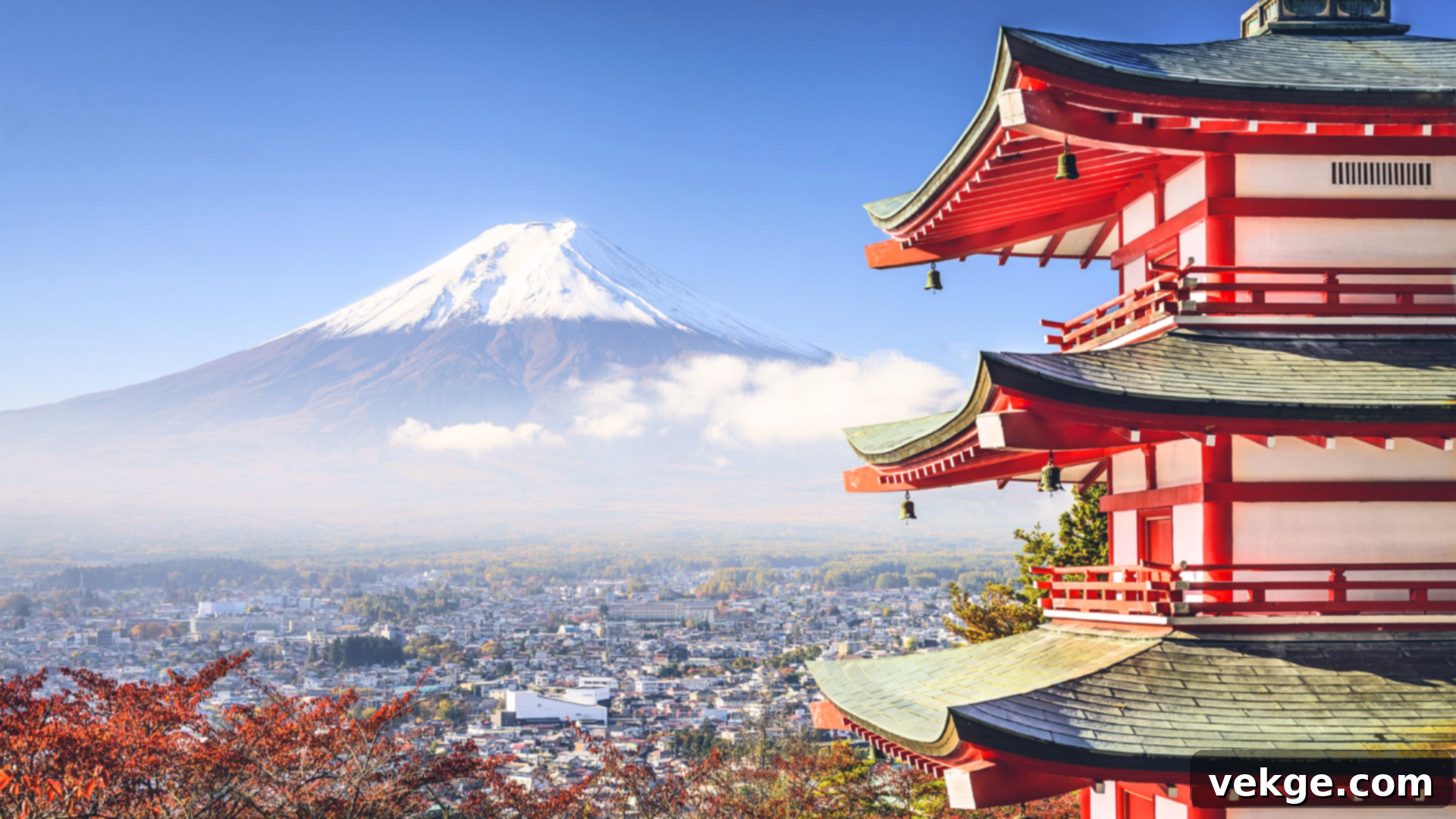
Mount Fuji, Japan’s highest and most revered mountain, stands at an impressive 12,389 feet (3,776 meters) and is celebrated worldwide for its almost perfectly symmetrical cone shape. This majestic stratovolcano is not only a dominant feature of the Japanese landscape but also a profound sacred symbol in Japanese culture, inspiring countless artworks, poems, and spiritual practices. For many travelers, climbing Mount Fuji during the designated season or simply admiring its serene beauty from nearby lakes and picturesque towns like Hakone or Kawaguchiko, represents a profound highlight of their visit to Japan.
Best Times to Visit: The official climbing season for Mount Fuji is during July and August. These months offer the safest weather conditions for ascents, with mountain huts and facilities fully operational.
Visiting Hours: While the mountain itself is always present, it is officially open for climbing 24 hours a day during the designated climbing season. Early morning climbs are particularly popular for reaching the summit in time to witness a spectacular sunrise above the clouds.
29. Bibi-Khanym Mosque, Uzbekistan
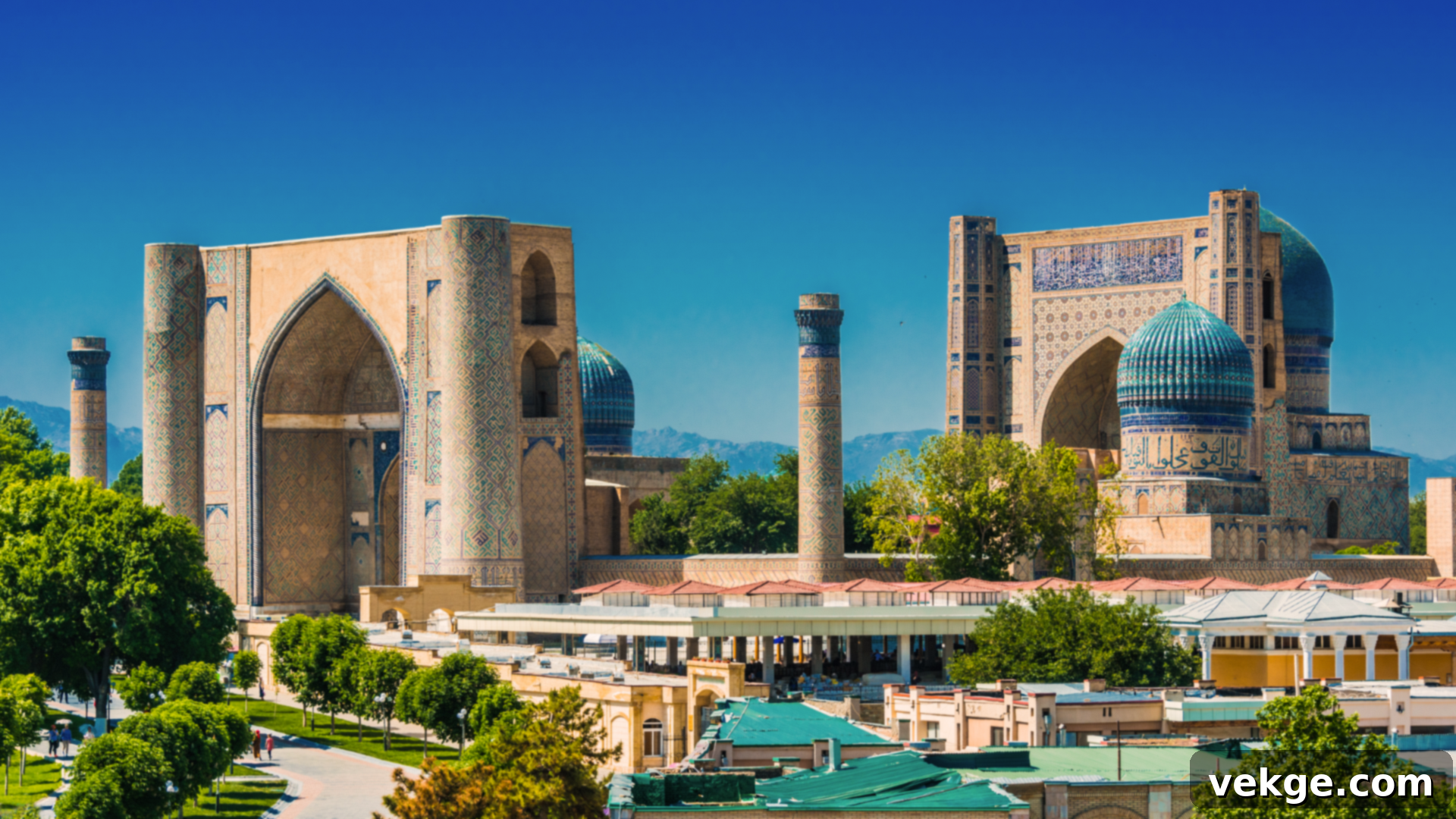
The Bibi-Khanym Mosque, located in the ancient city of Samarkand, was once one of the largest and most magnificent mosques in the entire Islamic world. Commissioned in the early 15th century by the formidable Turkic conqueror Timur (Tamerlane) after his campaign in India, it was designed to be his grandest architectural triumph. The mosque features colossal blue domes, grand arched portals, and exquisitely intricate tilework adorned with calligraphy and geometric patterns, beautifully reflecting the zenith of Timurid architecture and its ambitious scale, a testament to Samarkand’s golden age.
Best Times to Visit: For comfortable temperatures and clear skies ideal for exploring Samarkand’s architectural wonders, visit Bibi-Khanym Mosque during spring (April to June) and fall (September to October).
Visiting Hours: The mosque is generally open daily from 9:00 AM to 7:00 PM. Early mornings and late afternoons are recommended for softer light, which enhances the beauty of the tilework for photography, and to experience the site with fewer crowds.
30. Darvaza Gas Crater, Turkmenistan
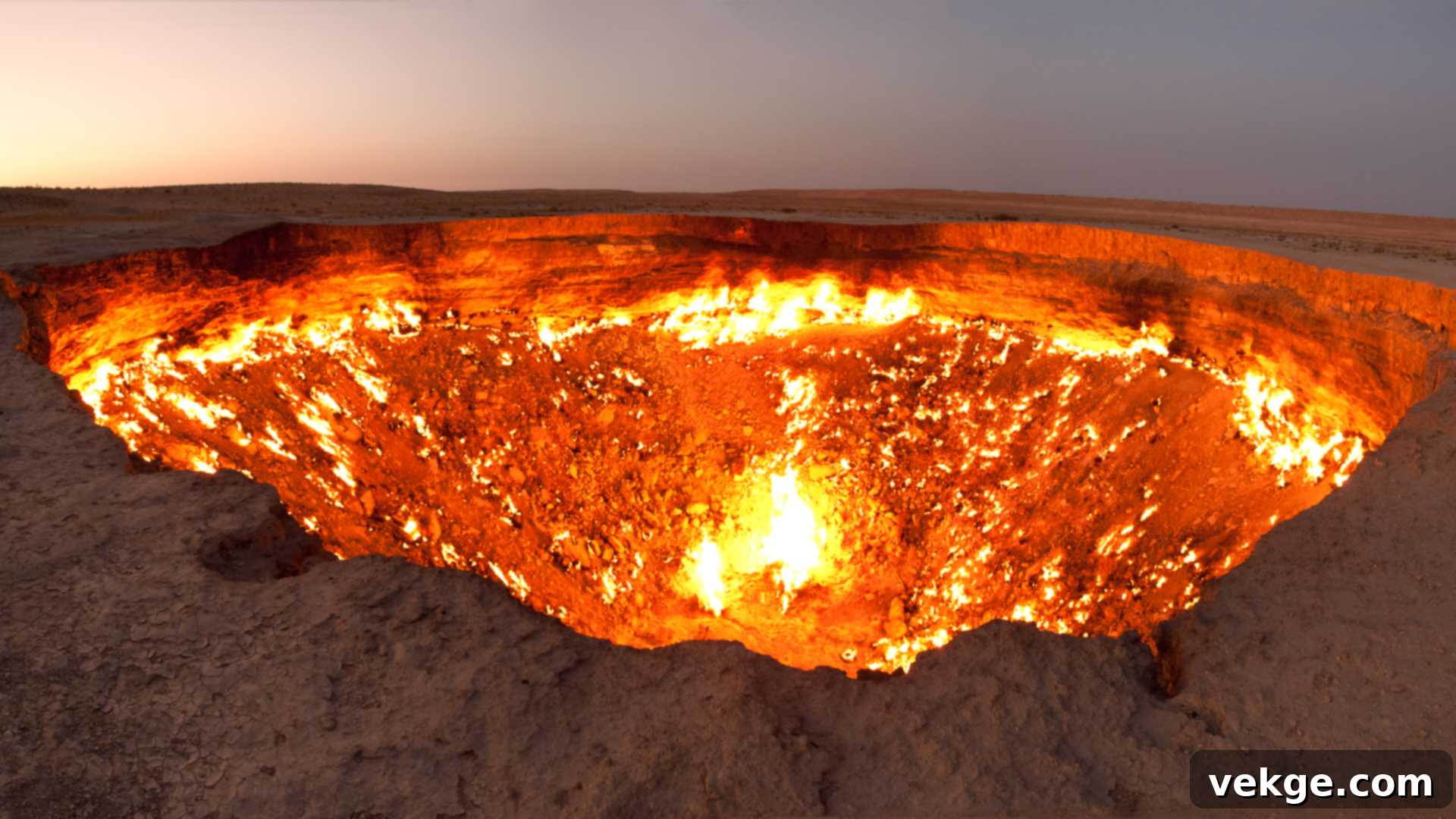
The Darvaza Gas Crater, famously dubbed the “Door to Hell,” is an extraordinary and surreal fiery pit nestled in the desolate Karakum Desert of Turkmenistan. This astonishing natural gas field has been burning continuously since 1971, when a Soviet drilling accident caused the ground to collapse, releasing vast quantities of natural gas that were intentionally ignited to prevent the spread of toxic methane. The incandescent, glowing crater, especially under the shroud of night, offers a truly unique, otherworldly, and unforgettable sight, drawing adventurous travelers to its remote location.
Best Times to Visit: To experience milder desert temperatures, which can be extreme, plan your visit to the Darvaza Gas Crater between March and May or from September to November.
Visiting Hours: The Darvaza Gas Crater is a natural phenomenon accessible all day and night. However, nighttime visits are unequivocally the best time to witness the crater’s full, mesmerizing fiery glow against the dark desert sky, creating a truly spectacular display.
31. Baiterek Monument, Kazakhstan

The Baiterek Monument, a striking and futuristic tower located in Astana (formerly Nur-Sultan), stands as a powerful symbol of Kazakhstan’s modern identity and aspirations. Rising to a height of 318 feet (97 meters), its unique design represents a mythical tree of life, with a gleaming golden orb at its apex symbolizing a magical egg laid by a sacred bird. Visitors can ascend via an elevator to an observation deck nestled within this golden “egg,” offering unparalleled panoramic views of the city’s innovative architecture and rapidly developing skyline, embodying the nation’s progress.
Best Times to Visit: The months between May and September offer warm and pleasant weather conditions, making it an ideal time for sightseeing and enjoying the outdoor views from the Baiterek Monument.
Visiting Hours: The Baiterek Monument is open daily from 10:00 AM to 9:00 PM. An evening visit provides particularly beautiful sunset views over the city, followed by the dazzling spectacle of Astana’s lights.
32. Nasir al-Mulk Mosque, Iran
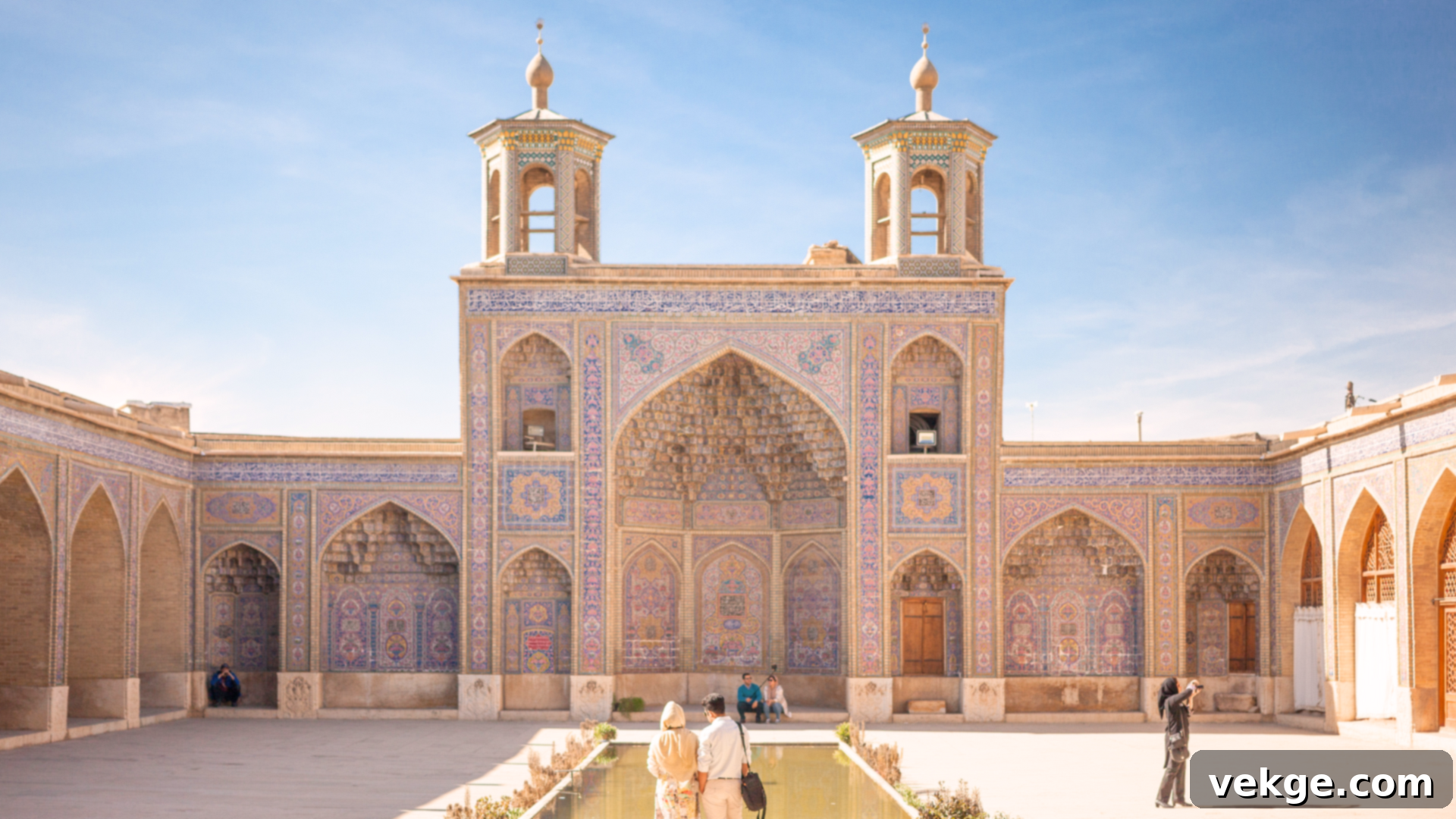
Nasir al-Mulk Mosque, affectionately known as the “Pink Mosque,” is an architectural gem located in Shiraz, Iran, renowned for its extraordinary beauty and play of light. This 19th-century Qajar-era mosque is particularly famous for its magnificent stained glass windows, which, when the morning sun shines through, cast a kaleidoscopic rainbow of vibrant colors across its Persian carpets and intricate floor tiles. The mosque’s delicate tile work, featuring subtle pink hues and floral motifs, combined with this dazzling light display, creates a truly enchanting and unforgettable experience, making it a must-visit landmark for photographers and culture enthusiasts.
Best Times to Visit: To experience the most comfortable weather for exploring Shiraz, visit the Nasir al-Mulk Mosque between March and May or from September to November.
Visiting Hours: The mosque is open daily from 7:00 AM to 5:00 PM. An early morning visit is absolutely essential to catch the sunlight streaming through the stained glass windows, creating its famous rainbow effect.
33. Shah Mosque, Iran
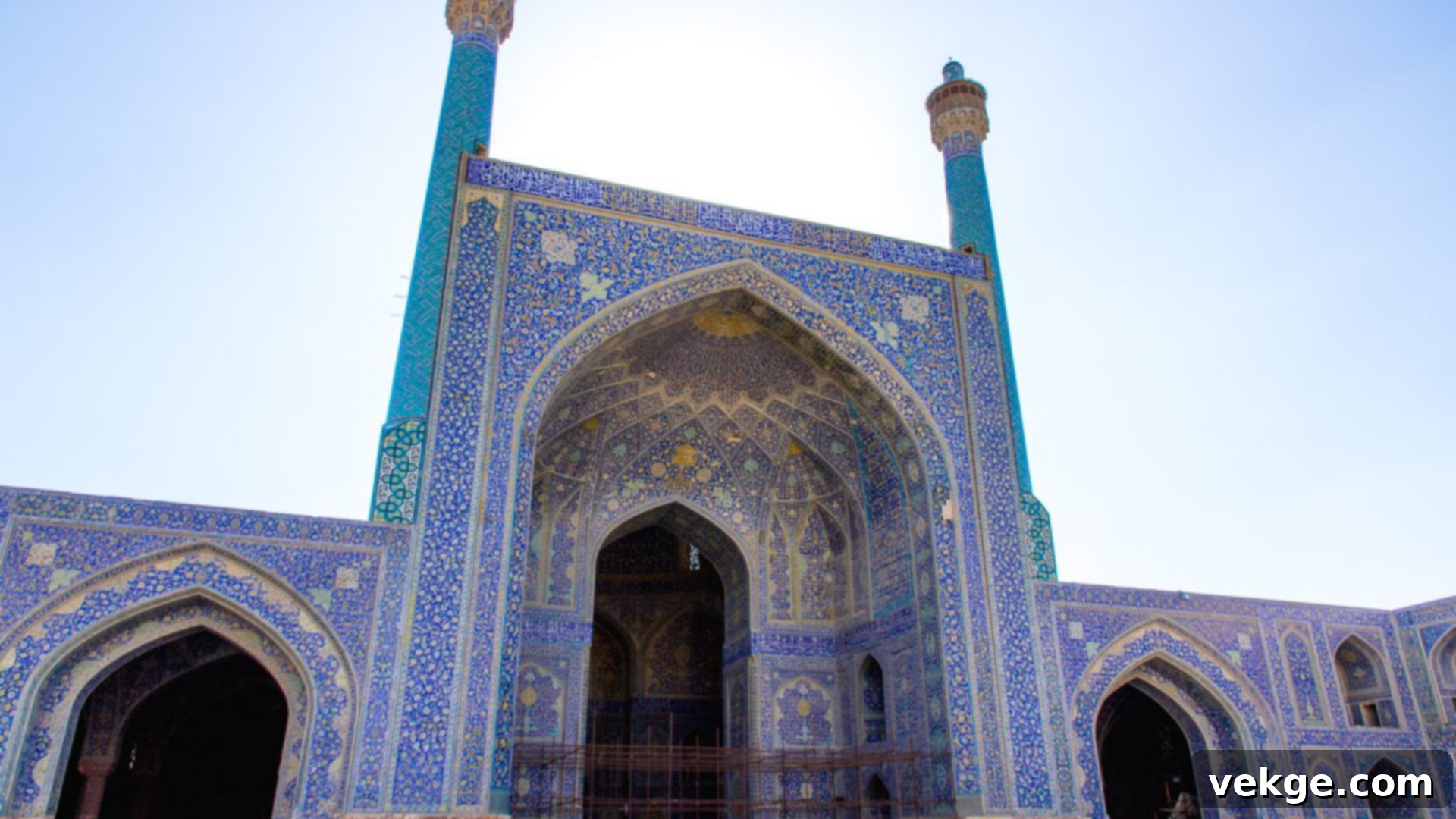
The Shah Mosque (also known as Imam Mosque), majestically situated on Isfahan’s renowned Naqsh-e Jahan Square, is considered a paramount masterpiece of Persian architecture from the Safavid era. Built in the early 17th century under Shah Abbas I, it captivates visitors with its stunning blue-tiled mosaics, soaring minarets, and a magnificent double-shelled dome that boasts remarkable acoustic properties – a single whisper under its center resonates perfectly throughout the space. Its unparalleled beauty, intricate craftsmanship, and innovative architectural features have made it an enduring symbol of Iran’s rich artistic and historical legacy, a UNESCO World Heritage site.
Best Times to Visit: For mild weather and comfortable conditions ideal for exploring the vast square and the mosque’s intricate details, plan your visit during spring (March to May) or fall (September to November).
Visiting Hours: The Shah Mosque is open daily from 9:00 AM to 5:00 PM. Morning visits are recommended for softer natural light, which beautifully illuminates the detailed tile work, making for excellent photographs and a serene experience.
34. Burj Khalifa, UAE
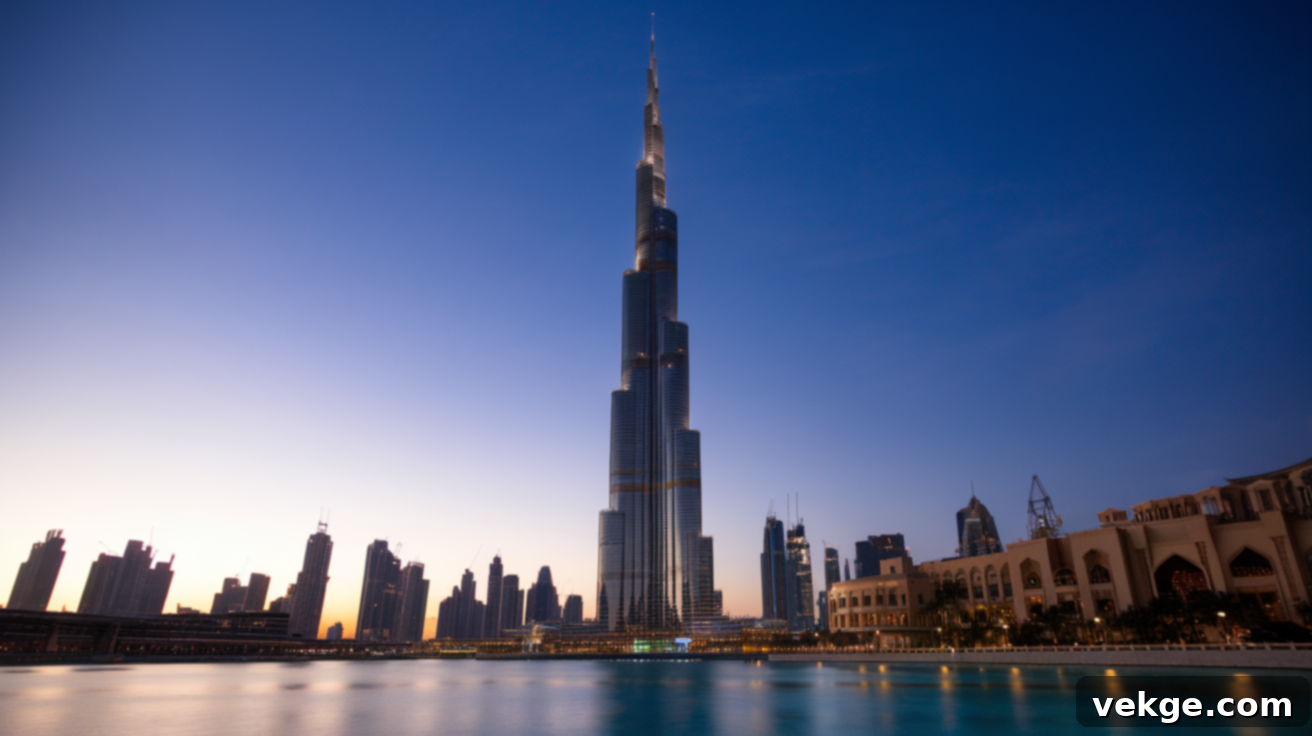
The Burj Khalifa, an awe-inspiring edifice in Dubai, proudly holds the title of the tallest building in the world, piercing the sky at an incredible height of 2,717 feet (828 meters). This modern marvel offers unparalleled panoramic vistas from its multiple observation decks, located on the 124th, 125th, and a premium experience on the 148th floors, providing breathtaking views of Dubai’s sprawling cityscape and beyond. Its sleek, innovative design and dominant presence on the global skyline make it an undisputed symbol of modern achievement, audacious ambition, and architectural excellence.
Best Times to Visit: To enjoy cooler and more comfortable sightseeing weather in Dubai, the period between November and April is highly recommended for visiting the Burj Khalifa.
Visiting Hours: The Burj Khalifa observation decks are open daily from 9:00 AM to 11:00 PM. Sunset visits are particularly popular, offering a spectacular transition from day to night with stunning city views and beautifully illuminated evening lights.
35. Sheikh Zayed Mosque, UAE
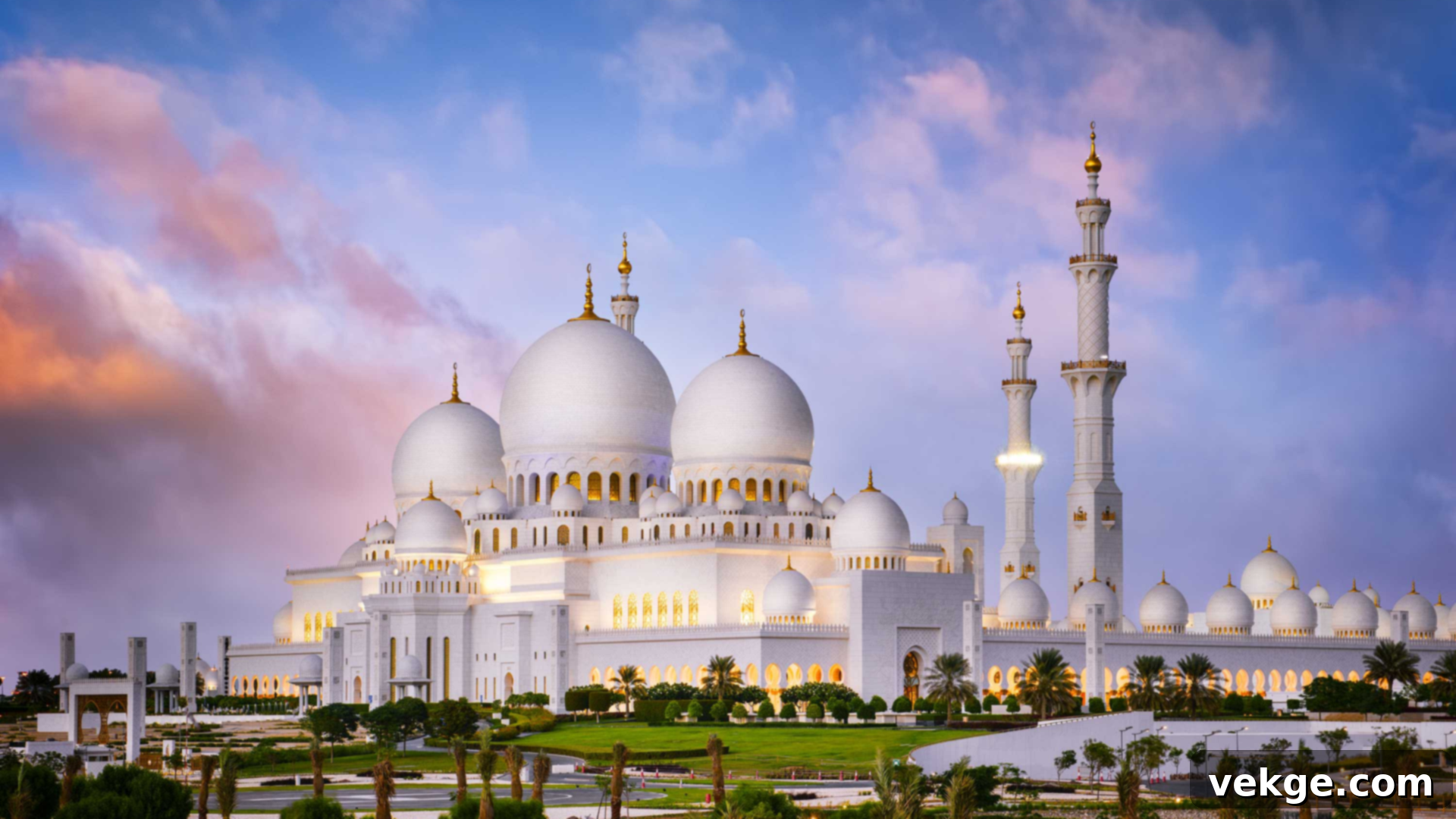
The Sheikh Zayed Grand Mosque, a magnificent architectural masterpiece located in Abu Dhabi, is one of the largest and most stunning mosques in the world. It is celebrated for its exquisite use of pristine white marble, adorned with intricate gold detailing and precious stones, and houses the world’s largest hand-knotted carpet. With its numerous brilliant white domes, reflective pools that mirror its grandeur, and delicate floral designs, the mosque warmly welcomes visitors of all faiths to admire its unparalleled beauty, serene atmosphere, and the profound craftsmanship that went into its creation, representing a harmonious blend of Islamic and modern architectural styles.
Best Times to Visit: The optimal time to visit the Sheikh Zayed Grand Mosque is between November and April, when Abu Dhabi’s weather is considerably cooler and more pleasant for outdoor exploration.
Visiting Hours: The mosque is open daily from 9:00 AM to 10:00 PM, with the exception of Friday mornings when it is closed for worshippers only. Evening visits are particularly breathtaking, offering spectacular views of the mosque illuminated beautifully under the night sky.
36. Petra, Jordan
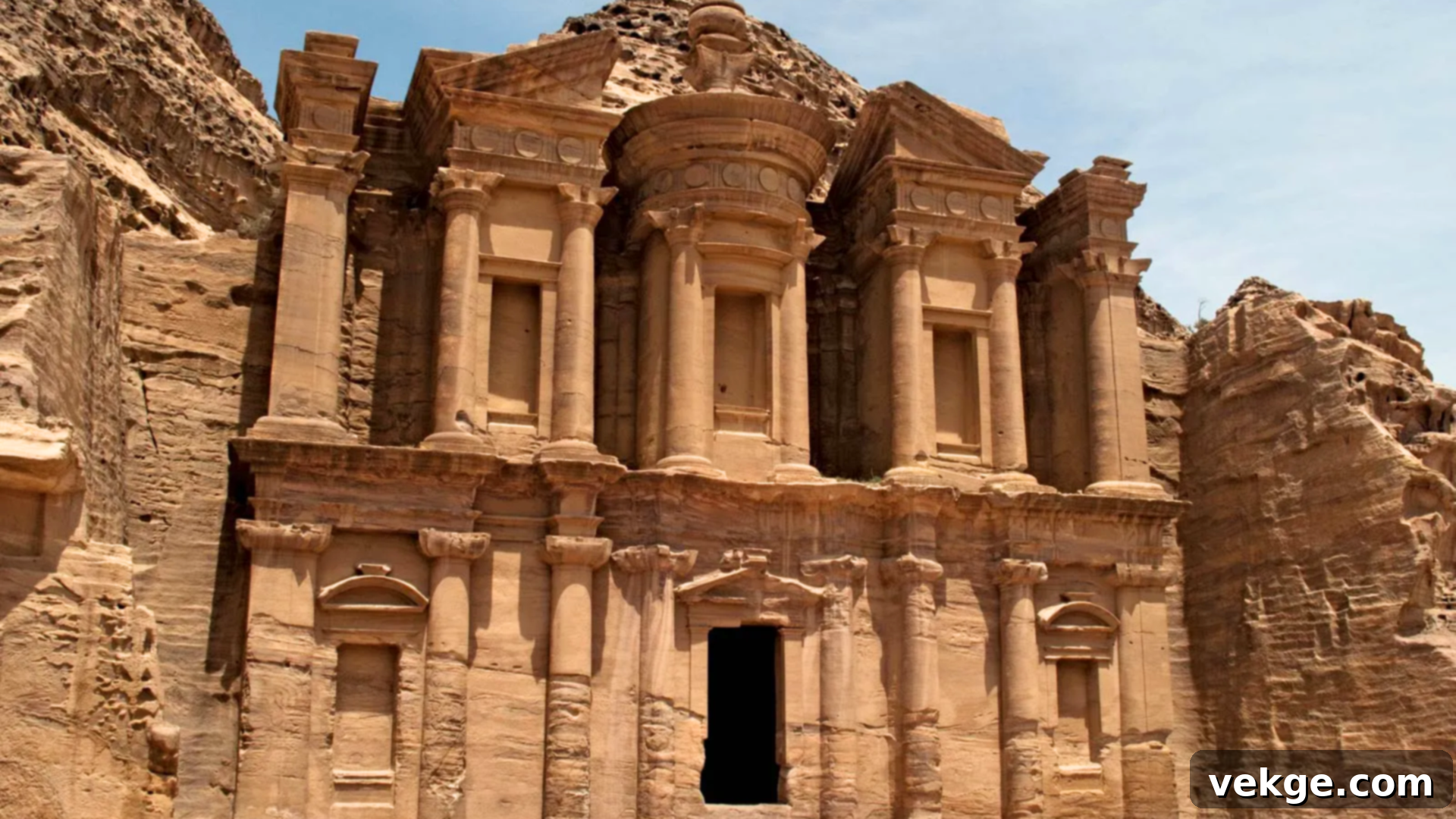
Petra, famously known as the “Rose City,” is an ancient archaeological city magnificently carved directly into rose-red sandstone cliffs in southern Jordan. This UNESCO World Heritage Site was established by the Nabataeans over 2,000 years ago and served as a vital trading hub. It features an array of impressive structures, including the iconic Treasury (Al-Khazneh), the vast Monastery (Ad Deir), and numerous elaborate hidden tombs. The dramatic walk through the narrow gorge, or Siq, culminating in the first glimpse of Petra’s wonders, is an absolutely unforgettable and truly awe-inspiring experience, transporting visitors back in time.
Best Times to Visit: For mild temperatures and comfortable hiking conditions crucial for exploring Petra’s extensive site, plan your visit during spring (March to May) or fall (September to November).
Visiting Hours: Petra is open daily from 6:00 AM to 6:00 PM. To avoid the peak heat of the day and larger tourist crowds, an early morning visit is highly recommended, allowing for a more serene and immersive exploration.
37. Mount Rinjani, Indonesia
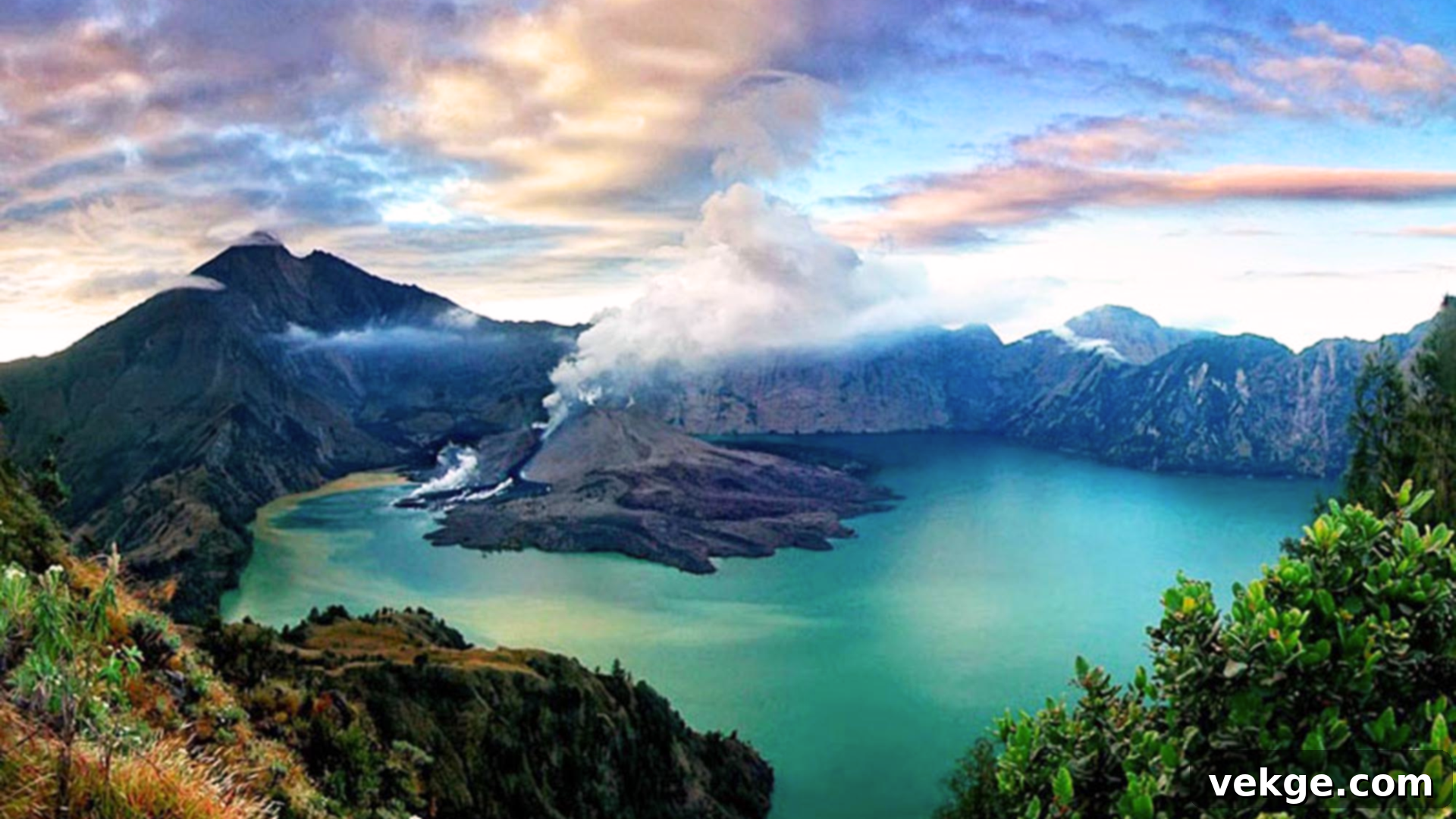
Mount Rinjani, a majestic active volcano located on Lombok Island, stands as the second-highest volcano in Indonesia and a revered natural wonder. Its impressive summit features a stunning, crescent-shaped crater lake named Segara Anak, which is home to natural hot springs and offers incredibly scenic trails. Trekking Rinjani is a challenging yet profoundly rewarding adventure, often spanning multiple days, but the breathtaking panoramic views from the summit at sunrise, overlooking the lake and surrounding islands, make every strenuous effort entirely worthwhile for serious hikers and nature enthusiasts.
Best Times to Visit: The dry season, from May to September, is the most suitable time to visit Mount Rinjani for trekking. During these months, trails are generally safer and weather conditions are clearer, offering the best experience.
Visiting Hours: Mount Rinjani is open for trekking during the dry season, with routes typically closed during the wet season for safety. Most multi-day hikes commence early in the morning to leverage cooler temperatures and reach campsites or the summit before intense heat sets in.
38. Gyeongbokgung Palace, South Korea
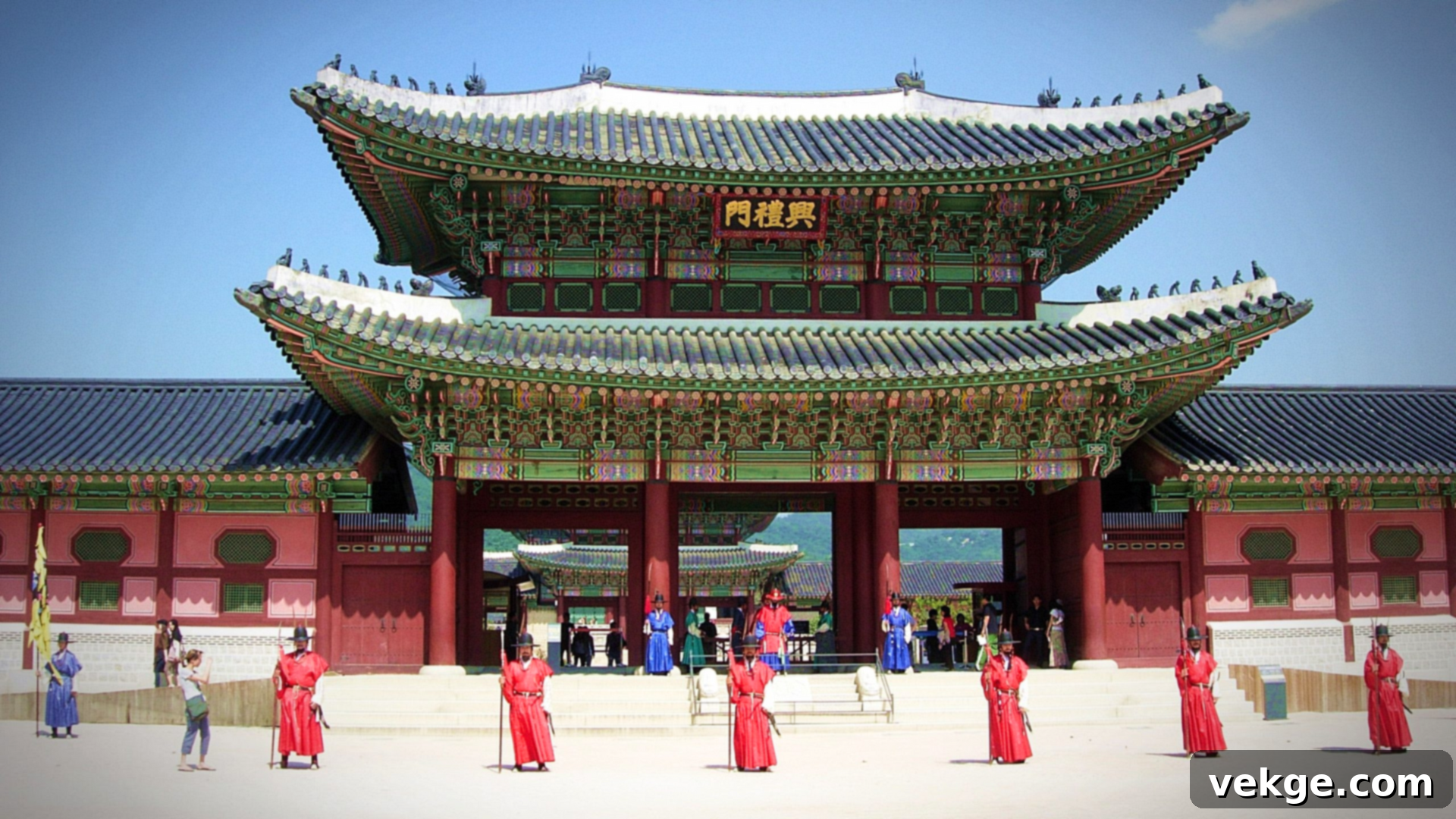
Gyeongbokgung Palace, prominently located in Seoul, served as the primary royal palace of the Joseon dynasty and is a magnificent example of traditional Korean architecture. Built in 1395, this grand complex features exquisitely preserved traditional buildings, serene scenic gardens, and impressive gates. Visitors can immerse themselves in history and culture, often renting traditional Hanbok attire for photos. A highlight of any visit is witnessing the colorful and meticulously choreographed changing of the guard ceremony, which takes place at the main Gwanghwamun Gate, offering a vivid glimpse into Korea’s royal heritage.
Best Times to Visit: To experience the palace in its most beautiful settings, visit in spring (March to May) for cherry blossoms and pleasant weather, or in fall (September to November) for stunning colorful autumn leaves and comfortable temperatures.
Visiting Hours: Gyeongbokgung Palace is open from Wednesday to Monday, 9:00 AM to 6:00 PM, and is closed on Tuesdays. Morning visits are recommended for cooler weather, fewer crowds, and the best photographic light.
39. Bukhara, Uzbekistan

Bukhara, one of Central Asia’s most ancient cities, boasts a rich history spanning over 2,000 years and is a UNESCO World Heritage Site. This remarkable city is a living museum, filled with impeccably preserved madrasahs, majestic mosques, intricate minarets, and historic trading domes that echo its glorious past as a major stop on the Silk Road. Wandering through Bukhara’s enchanting old town feels like stepping back in time, with its labyrinthine narrow streets, stunning Islamic architecture, and lively bazaars that continue to pulse with vibrant local life and centuries of tradition, offering an authentic cultural immersion.
Best Times to Visit: For pleasant temperatures and ideal conditions for extensive exploration of Bukhara’s historical sites, visit during spring (April to May) or fall (September to October).
Visiting Hours: Bukhara’s historic core is open for exploration throughout the day. Early mornings and late afternoons are particularly ideal for walking tours and photography, benefiting from softer light and a more tranquil atmosphere before or after the main tourist rush.
Conclusion
Asia is an extraordinary continent, brimming with an incredible array of famous landmarks that profoundly showcase its deep, layered history, vibrant cultures, and breathtaking natural beauty. Each destination on this list tells a unique and compelling story, offering something truly special and unforgettable for every type of traveler, from history buffs and spiritual seekers to nature lovers and urban explorers.
Now that you’ve journeyed through these amazing sites, from the ancient wonders of Angkor Wat to the modern marvels of the Burj Khalifa, you have a wealth of inspiration to begin planning your own remarkable adventures or simply to fuel your dreams of where you might explore one day. These iconic landmarks stand as powerful testaments to the incredible creations possible when human ingenuity and the grandeur of nature converge over time.
Remember, the most enriching travel experiences often begin with a spark of inspiration and a dash of curiosity. Keep exploring, stay curious about the world, and don’t hesitate to add your newly discovered favorite spots to your ultimate travel wish list. The adventure of a lifetime awaits!
If you’ve enjoyed discovering these famous landmarks in Asia, we encourage you to explore our other travel blogs for more exciting destination ideas and invaluable tips to enhance your next journey!
